Division is one of the four basic operations in arithmetic, along with addition, subtraction, and multiplication. It divides a group (or a number) into equal parts, resulting in an equal distribution. Giving your students a division worksheet and guiding them through the steps is the most effective way of educating them on the topic.
A simple way to explain this to your class could be the following: if you made 6 muffins that you wanted to give to your 3 friends, you would evenly distribute the muffins among the 3 people, meaning that each person would receive 2 muffins.
Division helps students in many ways. Firstly, it can help them divide bigger, more complex calculations into smaller, more manageable steps. Second, as children often become easily overwhelmed in math class, taking the time to divide tasks into small goals will help keep your kids motivated.
In the same way, it helps make complex word problems more manageable. As a result, your students will be able to use this method to resolve real-life problems, ultimately improving their problem-solving and analytical skills.
Finally, learning division will help them understand other concepts in mathematics. As division is directly related to the other three arithmetic operations, working on this skill will improve their overall comprehension of math. Math is often a complex subject for students to master. By giving them the tools to understand the subject conceptually, they will be more engaged in the long run.
This is why worksheets of divisions are so crucial. In the end, math is learned through practice. If your students become bored, it is always a good idea to keep them interested with some fun facts.
Here are just a few you can share with your students to keep them engaged:
- The division symbol is called an obelus.
- A whole number is divisible by 3 if the sum of its digits is divisible by 3. For example, 432 is divisible because 4 + 3 + 2 = 9
- The oblique bar was designed by De Morgan in 1945 and has since been used as a division sign.
Free Worksheets
Are you looking for division worksheets to use when teaching your students mathematical concepts? You can download our free, ready-to-use division worksheet templates. Our templates are easy to use and can be customized. For your convenience, you can download the format that best suits you.
Grade 3 practice worksheets
The topics covered in these worksheets include mental division, division with remainders, mental division, division facts, equations, long division, the order of operation, and even factoring.
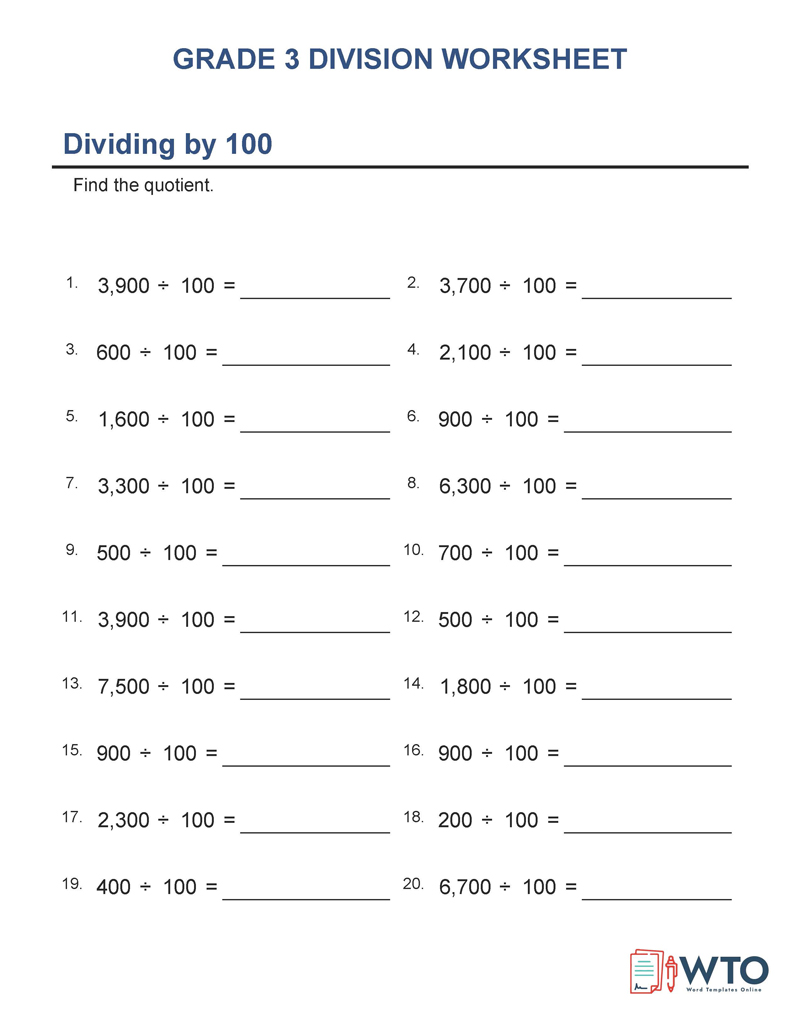
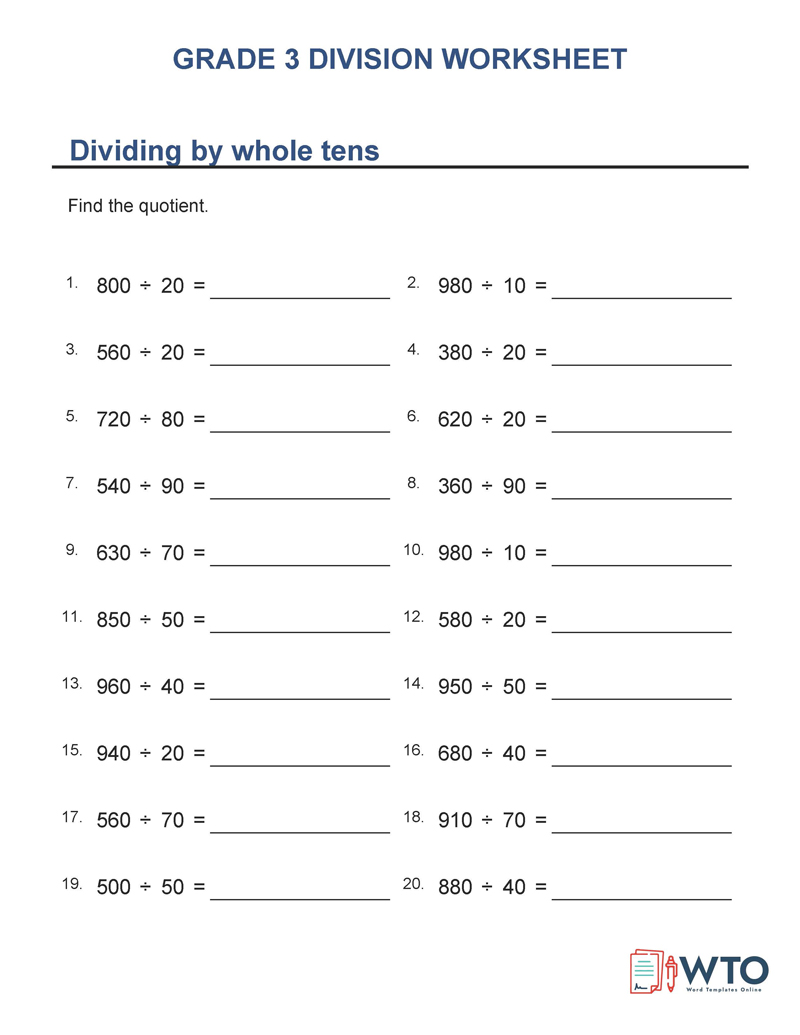
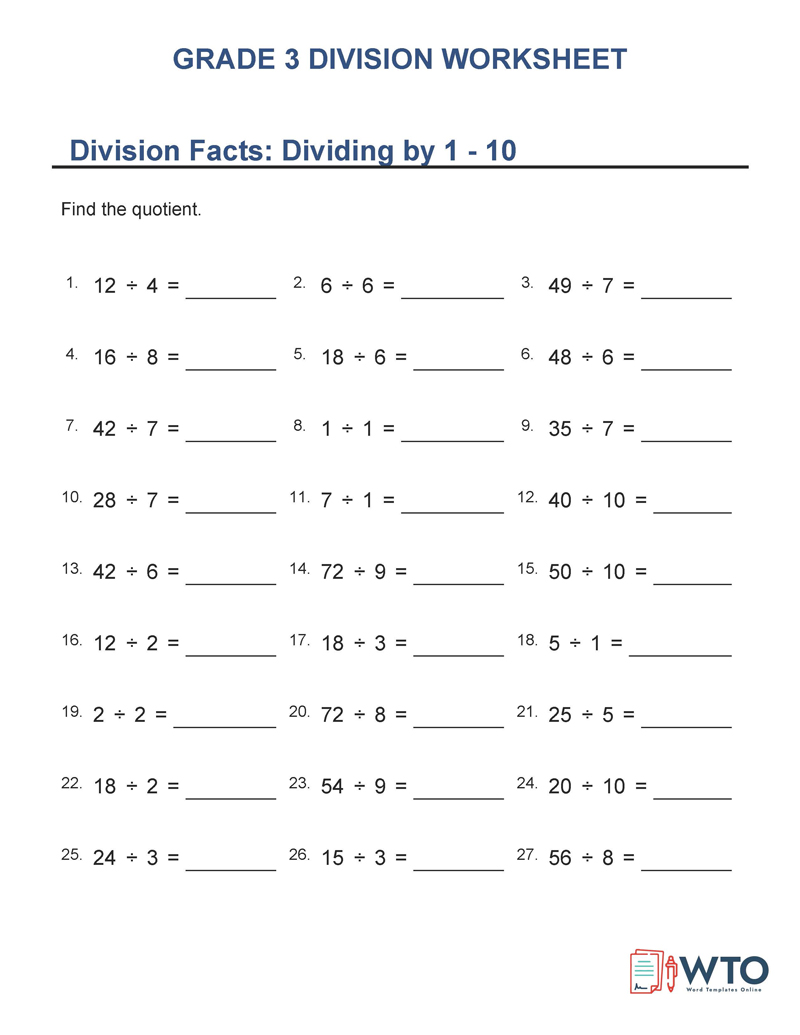
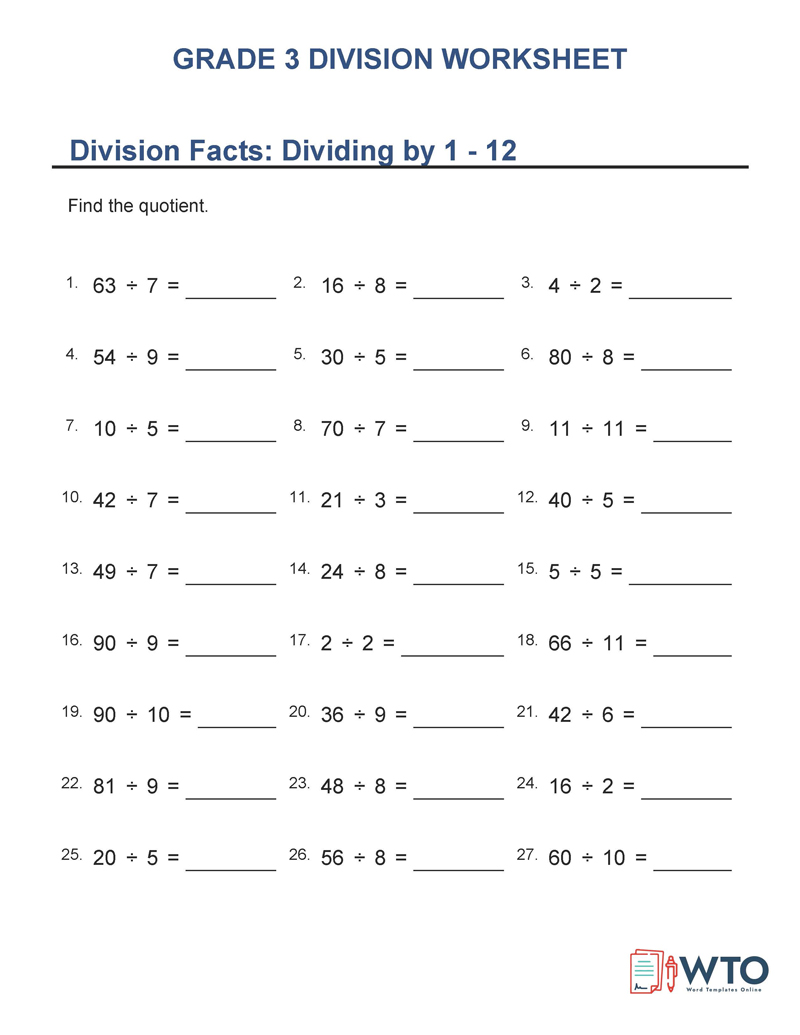
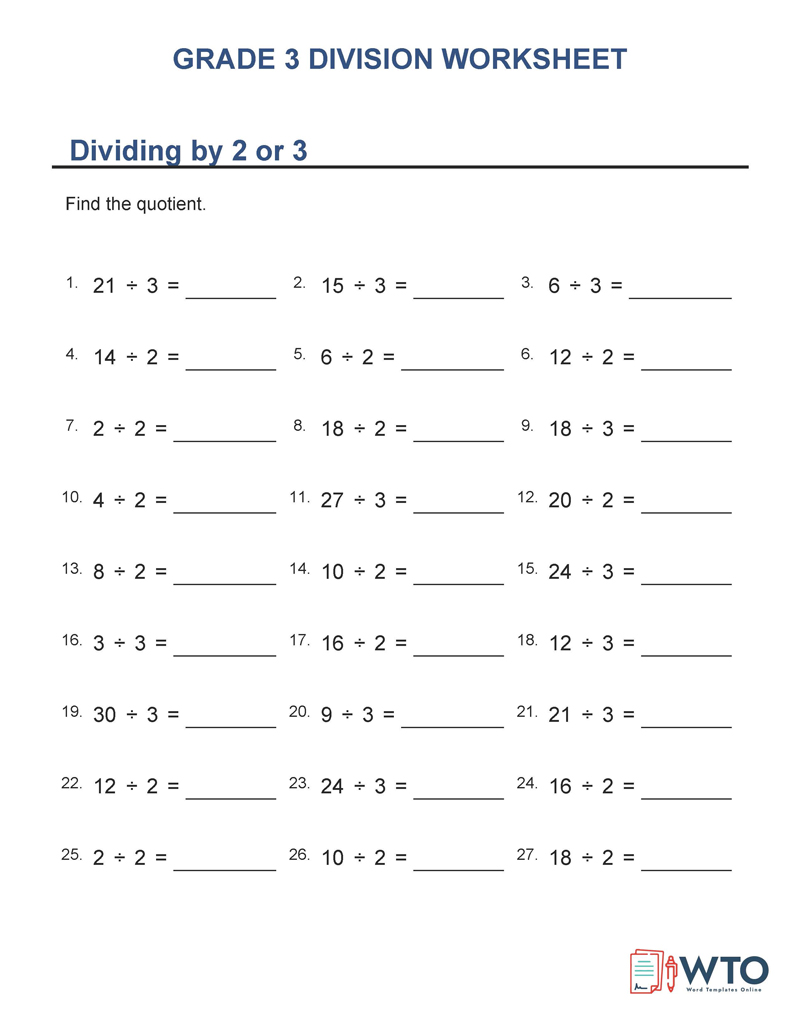
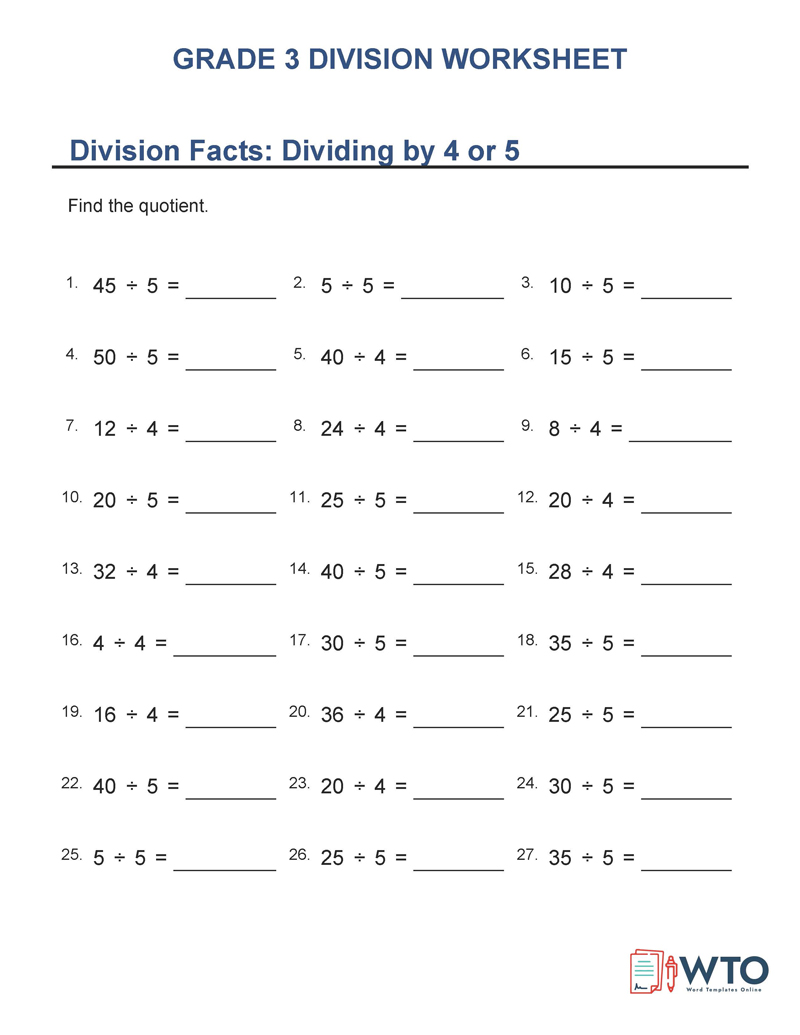
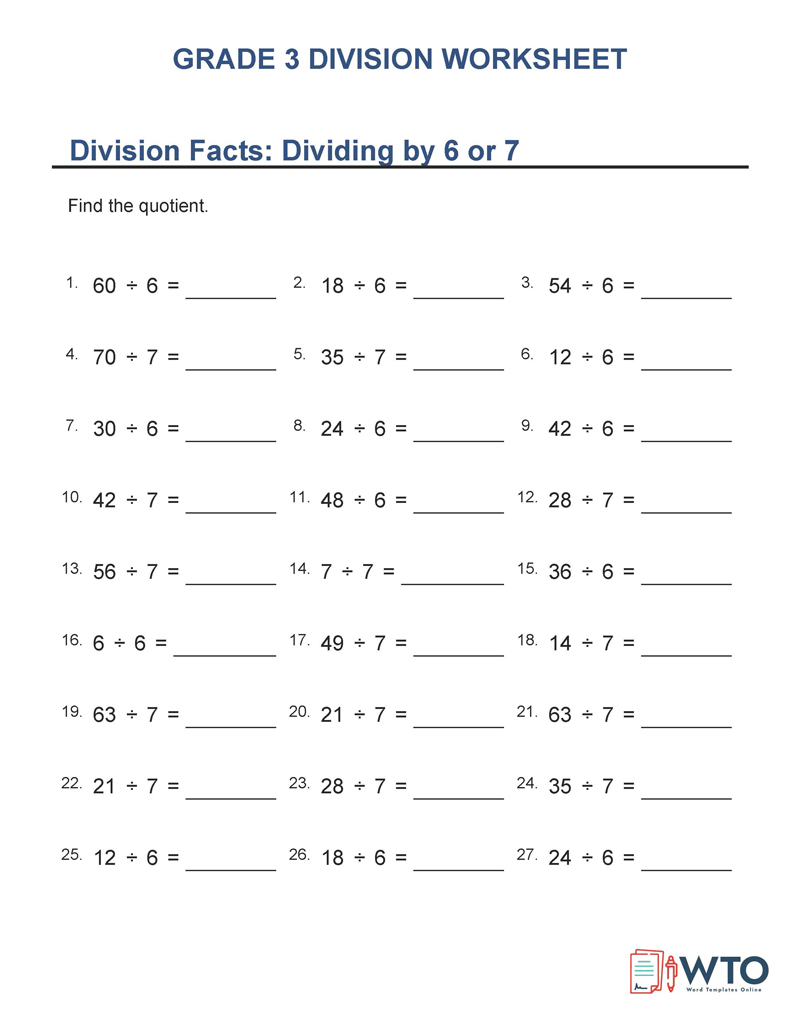
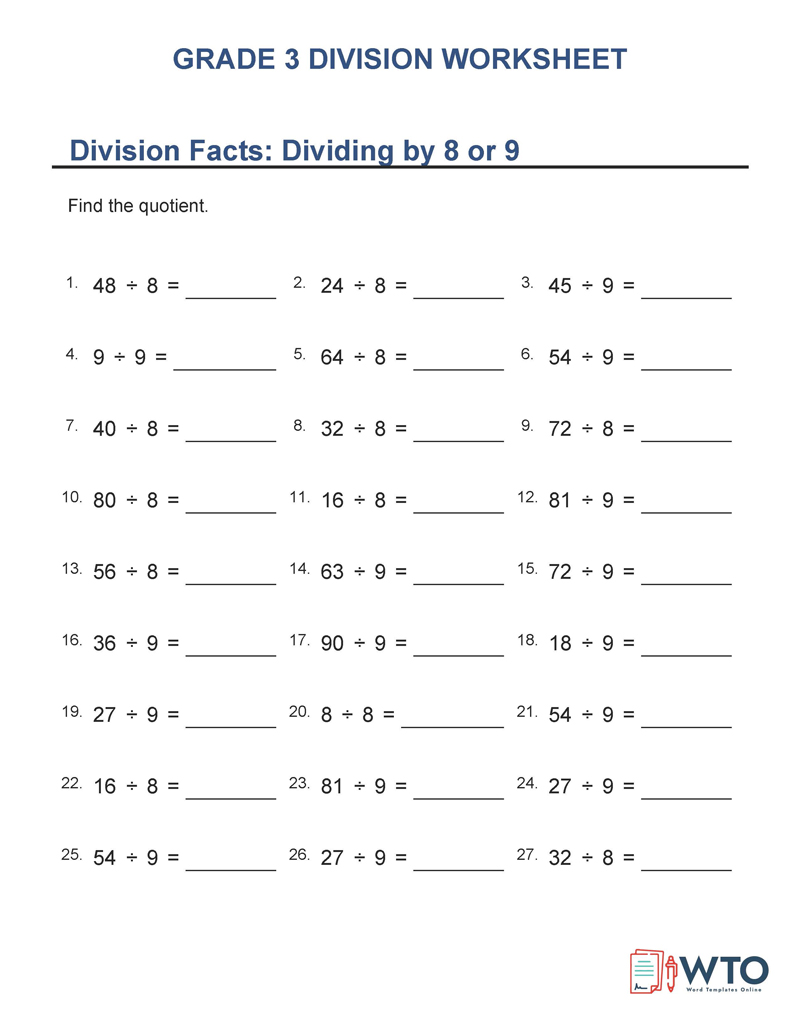
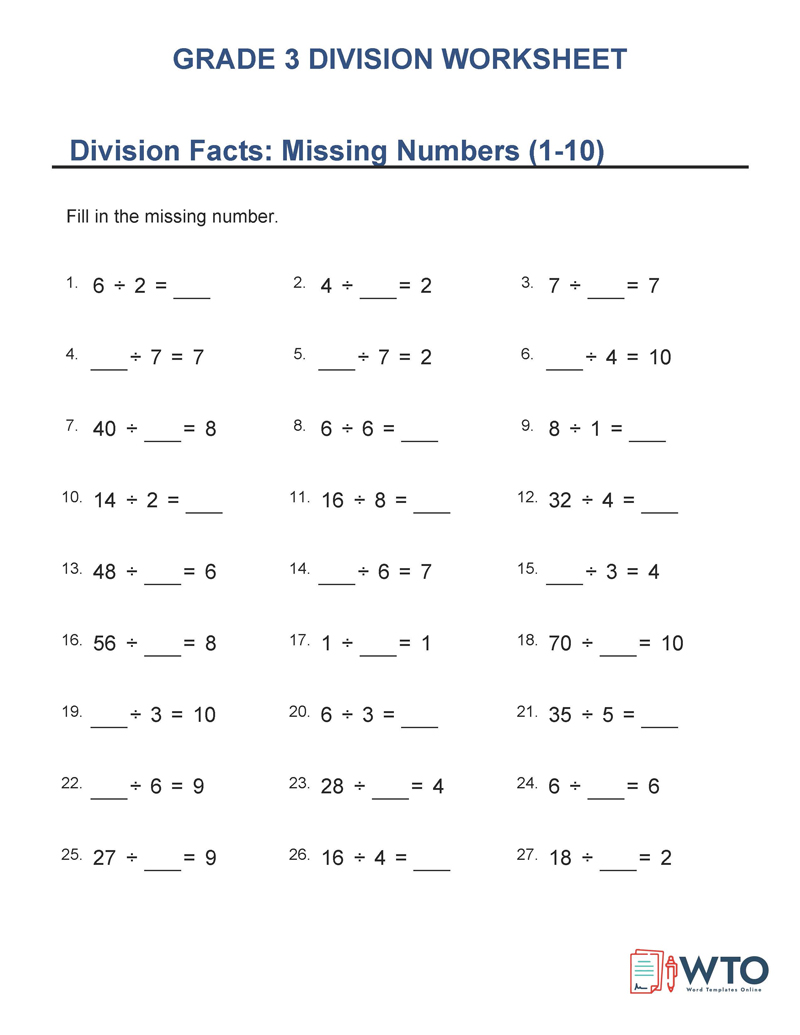
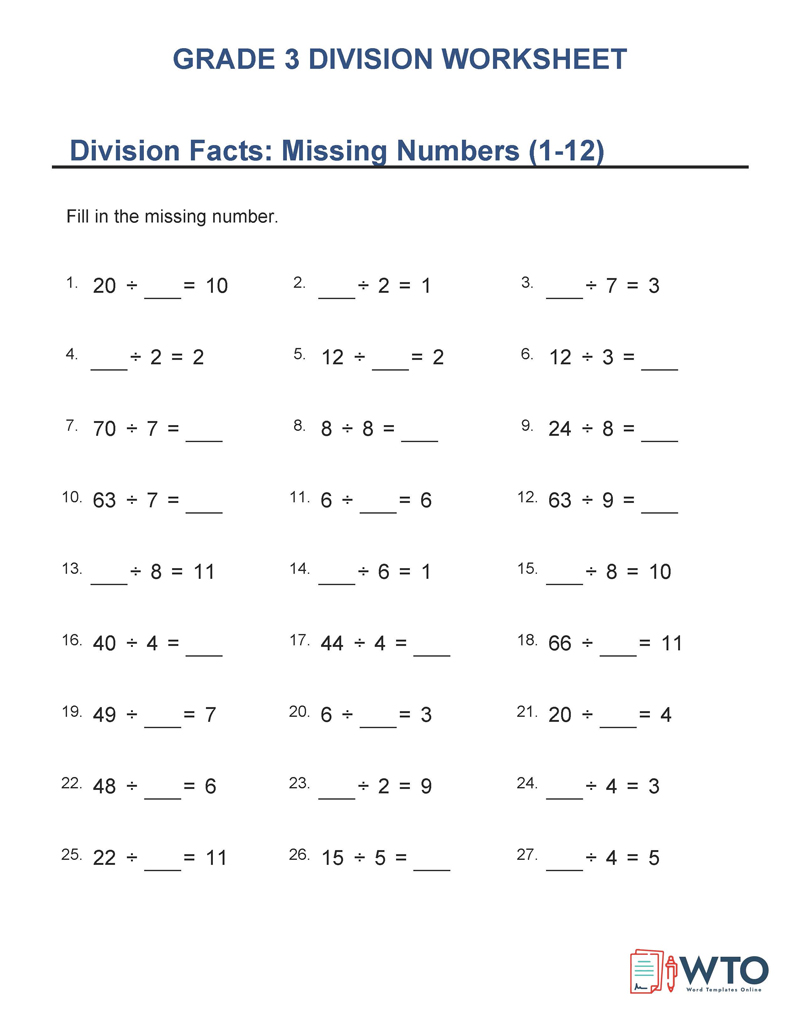
Grade 4 practice worksheets
These are worksheets that teachers provide to students to make learning easier. Students mostly use them for practicing technical mathematical problems without using calculators. It helps with their mental development; they can even divide odd numbers using even divisors.
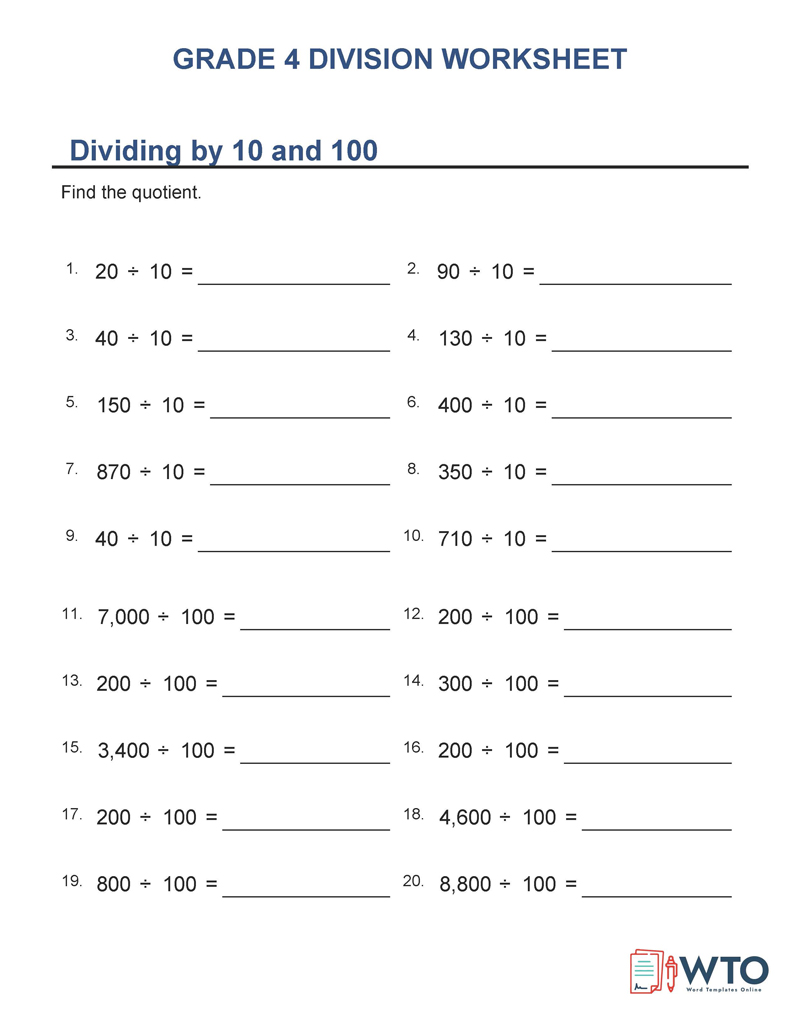
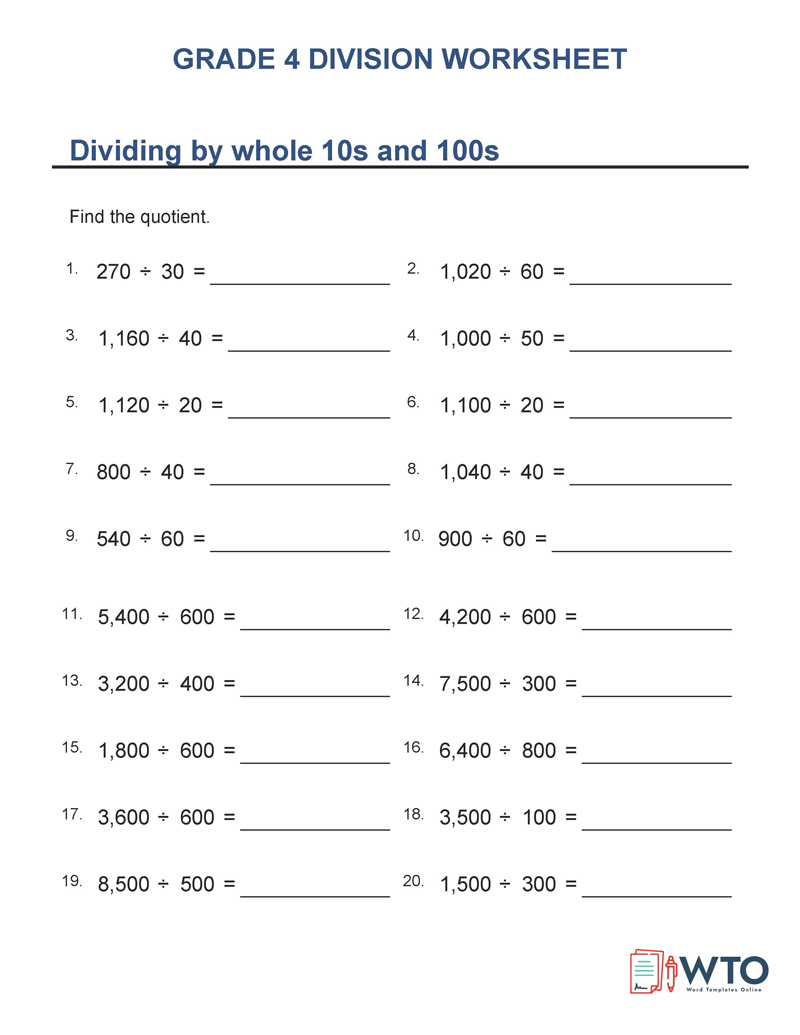
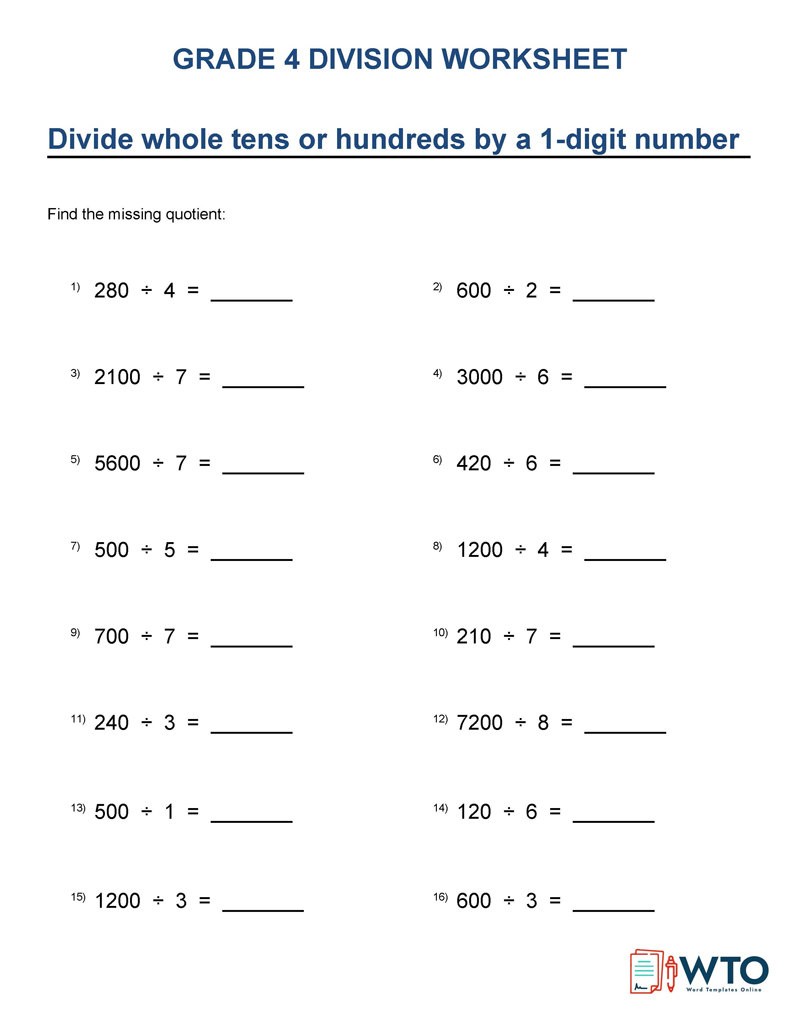
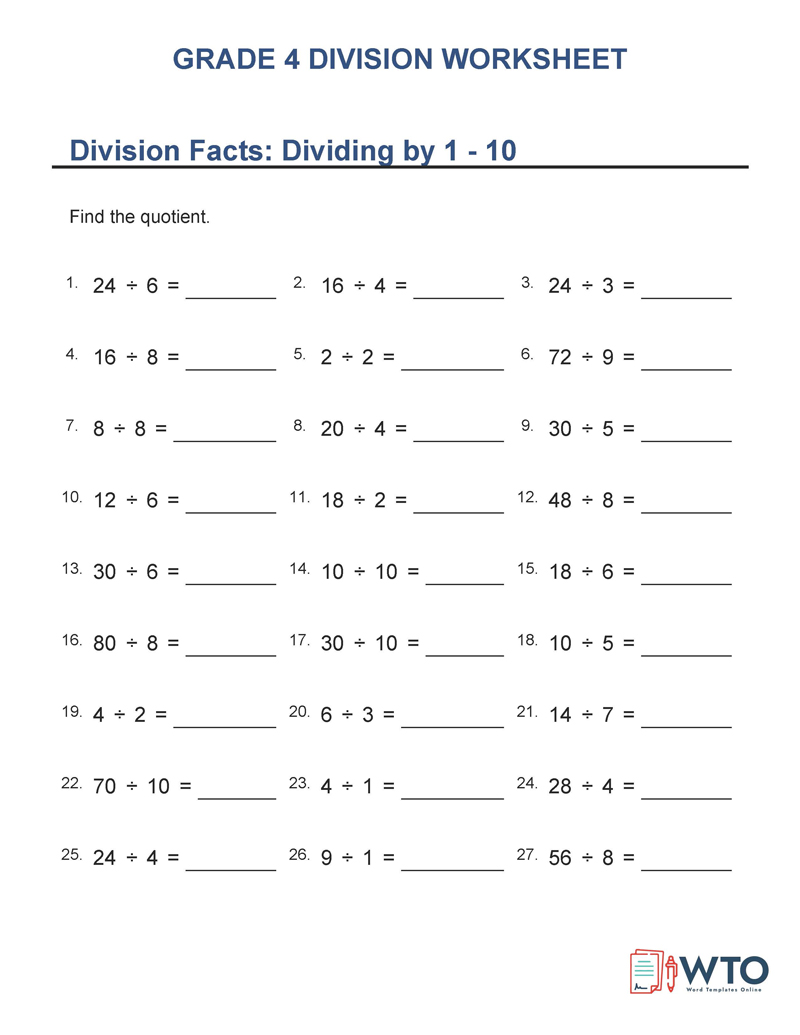
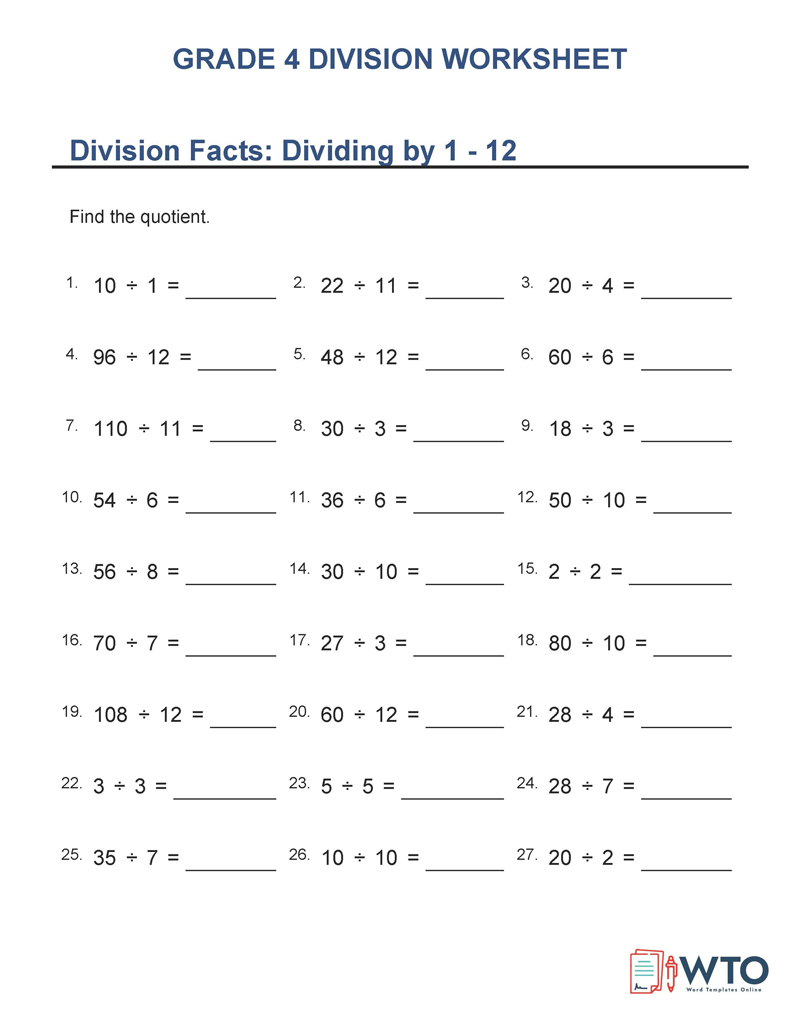
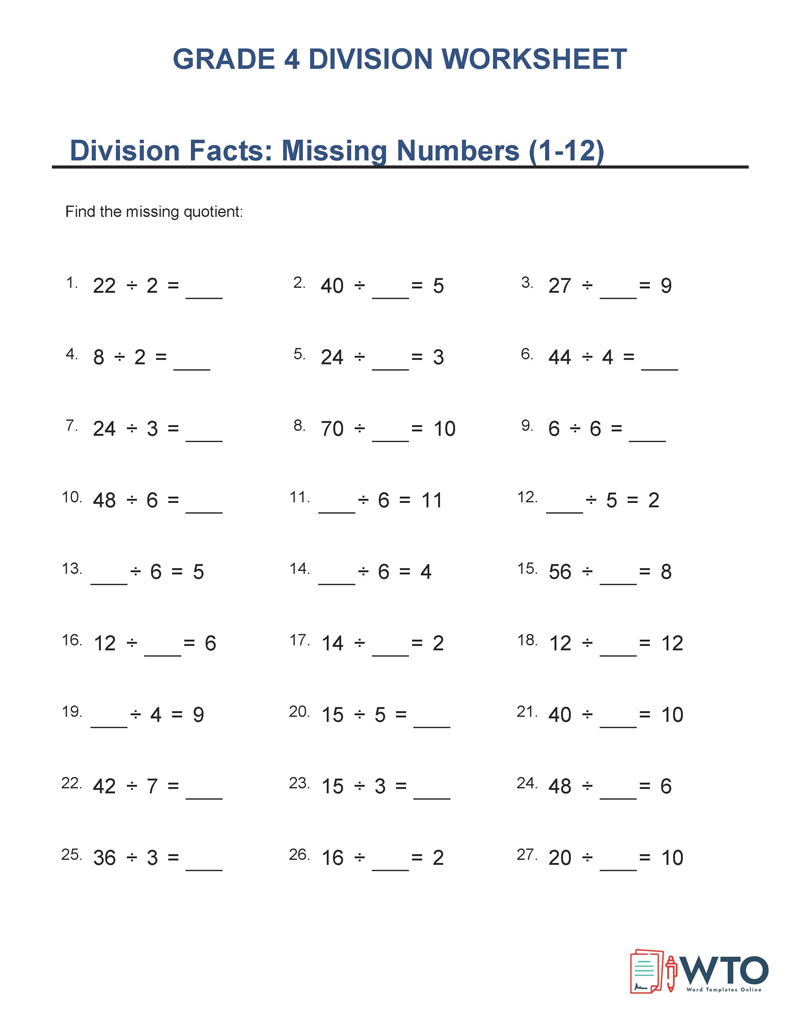
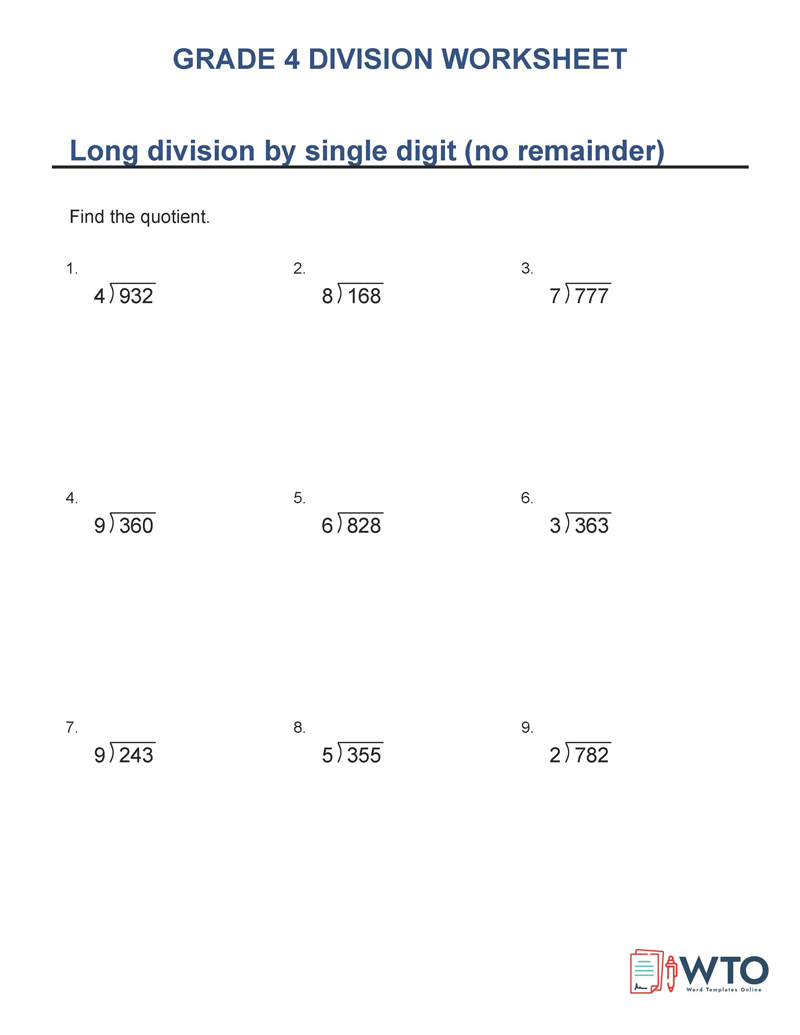
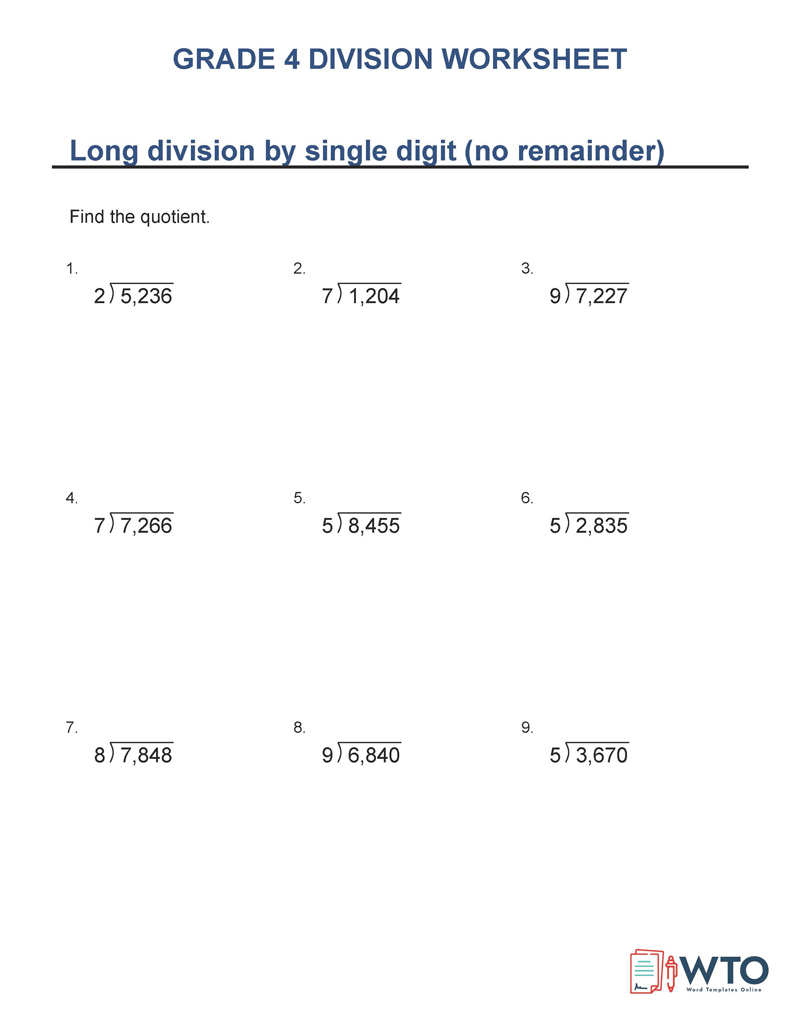
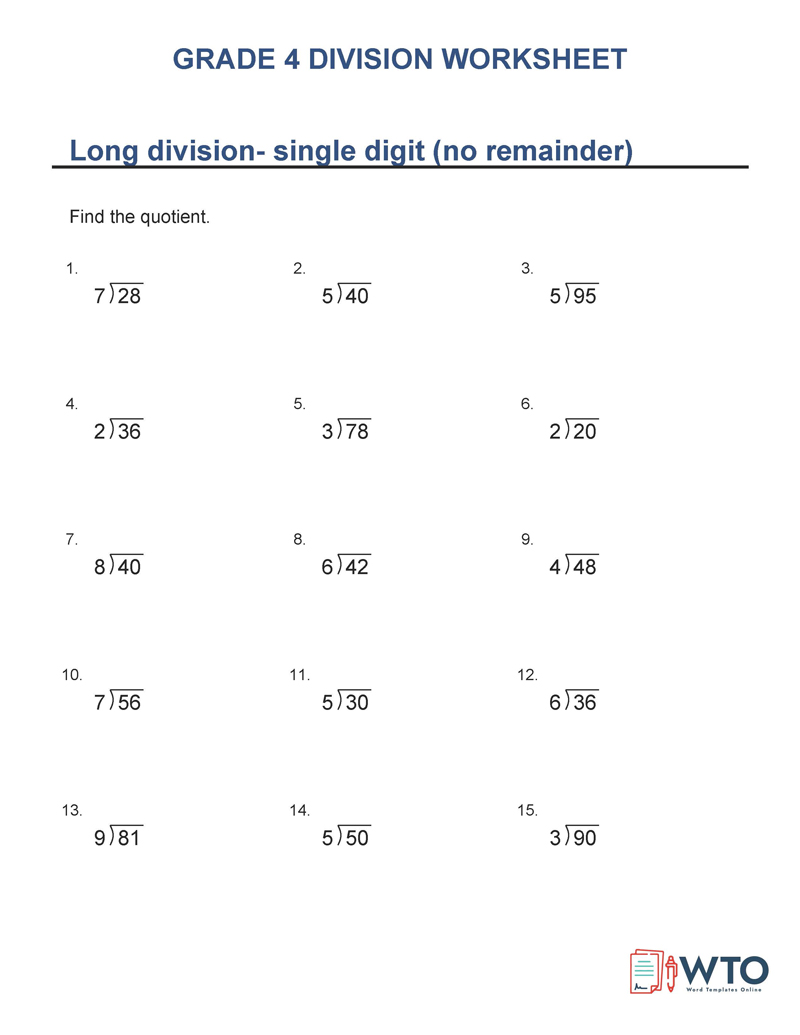
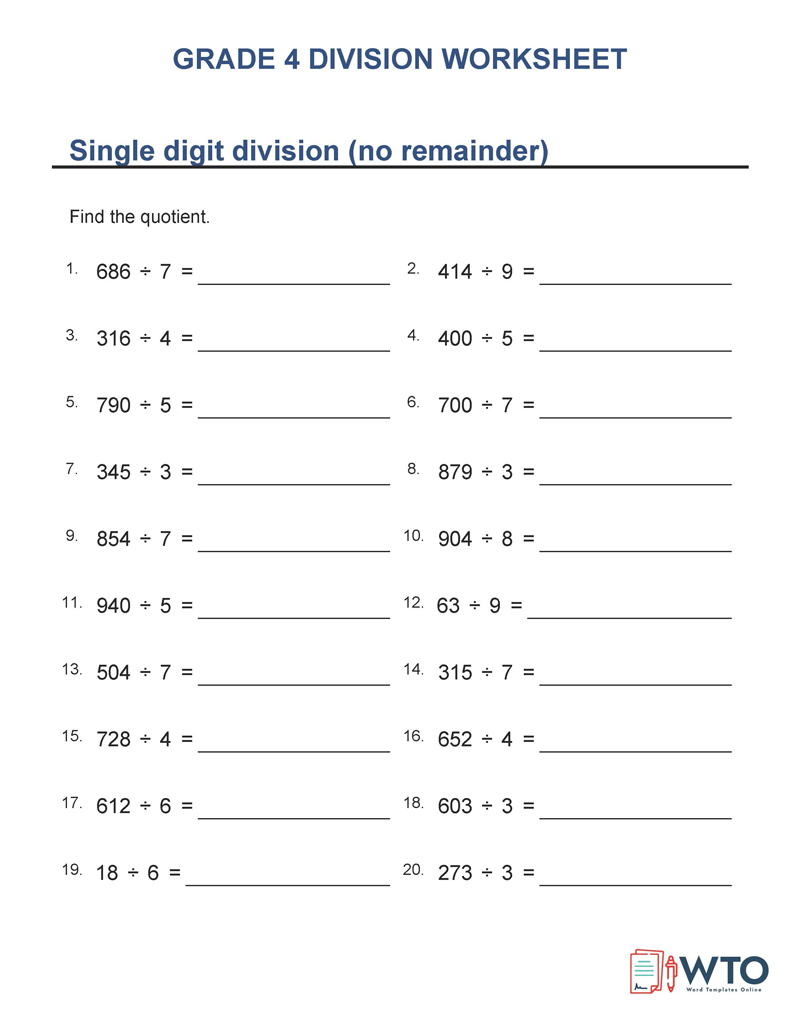
Grade 5 practice worksheet
The single-digit problems in the worksheet, which only evaluate one operation, can be printed on a single sheet of paper. It is usually given to students to increase their speed in solving mathematical problems. The questions can be 100 with a 5-minute time limit. Others have 20 issues to solve in 1 minute and 3 minutes to solve 60 puzzles.
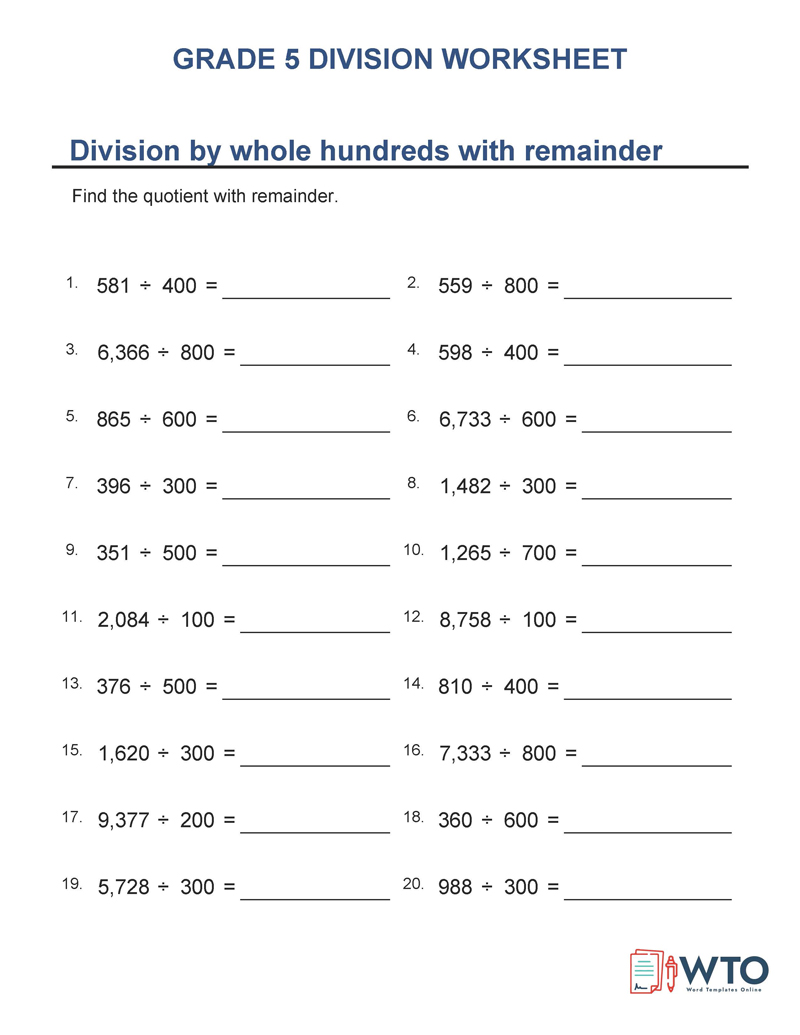
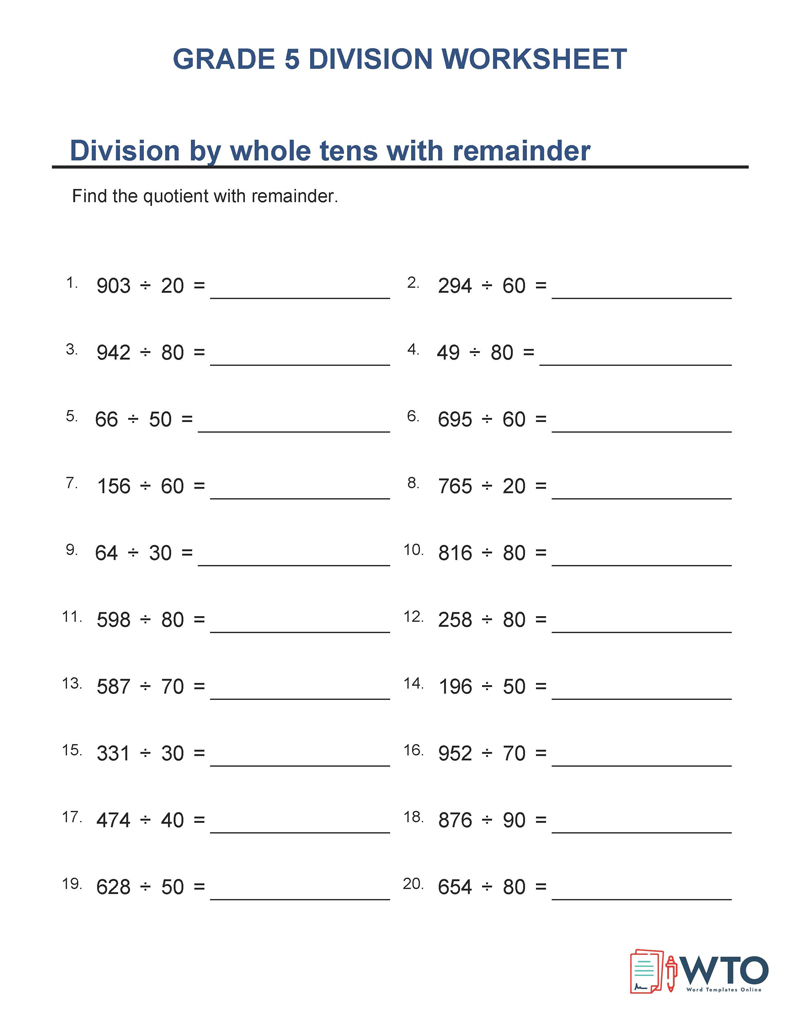
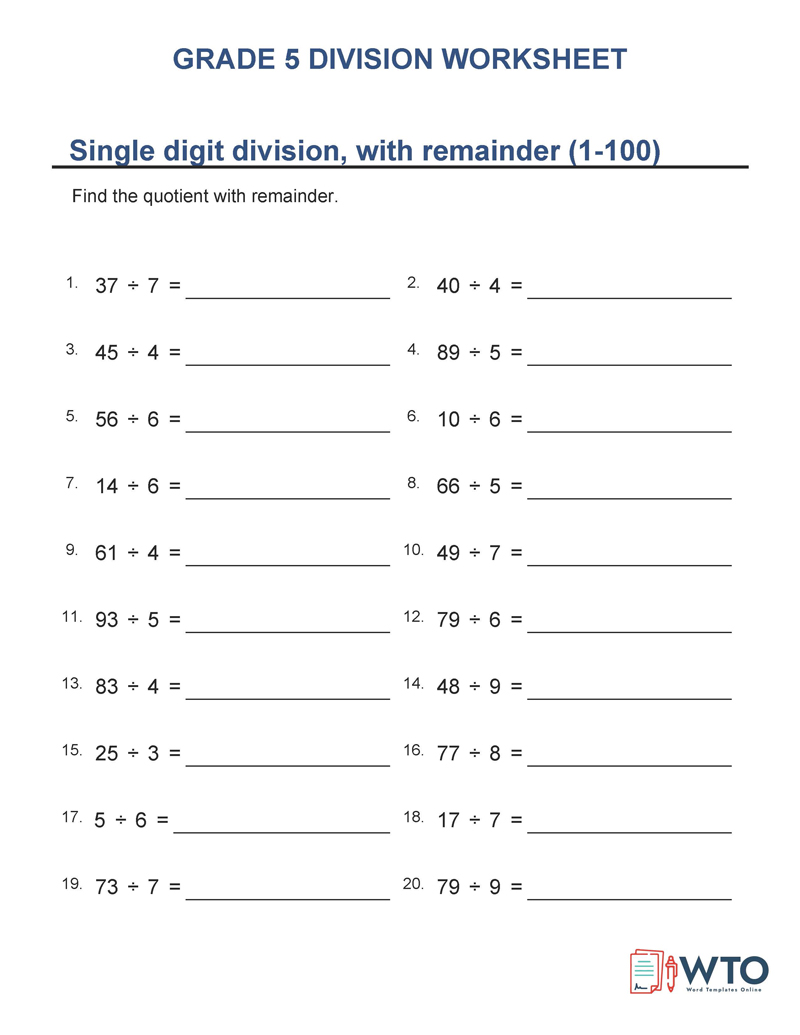
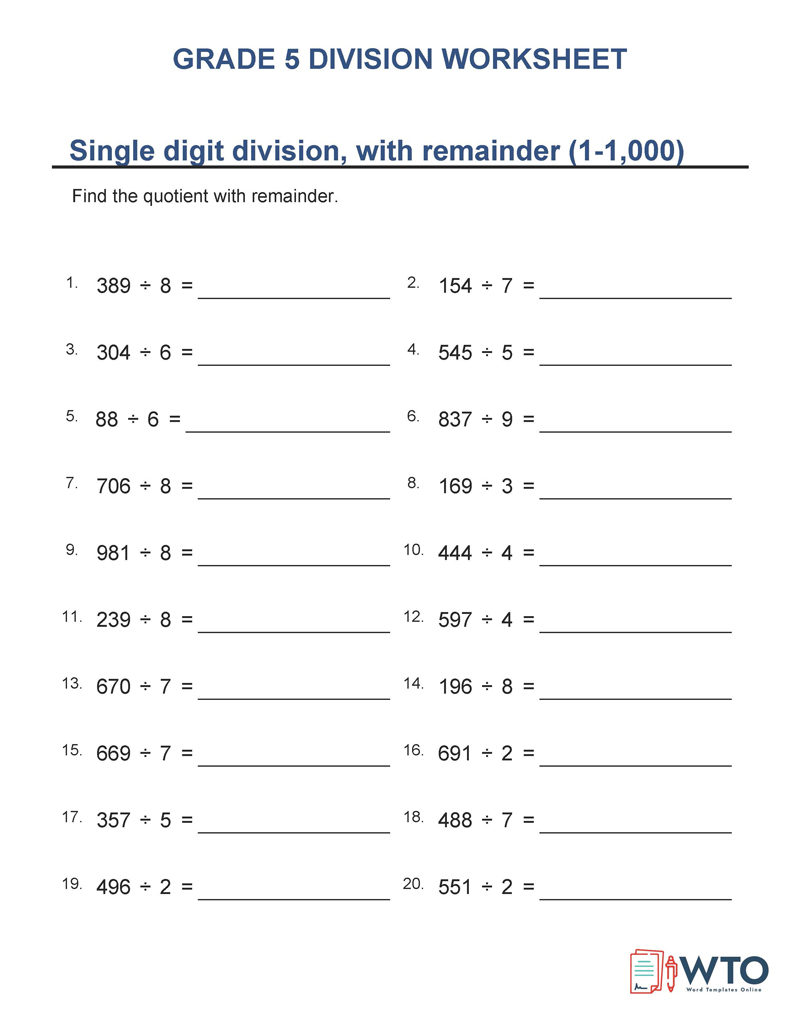
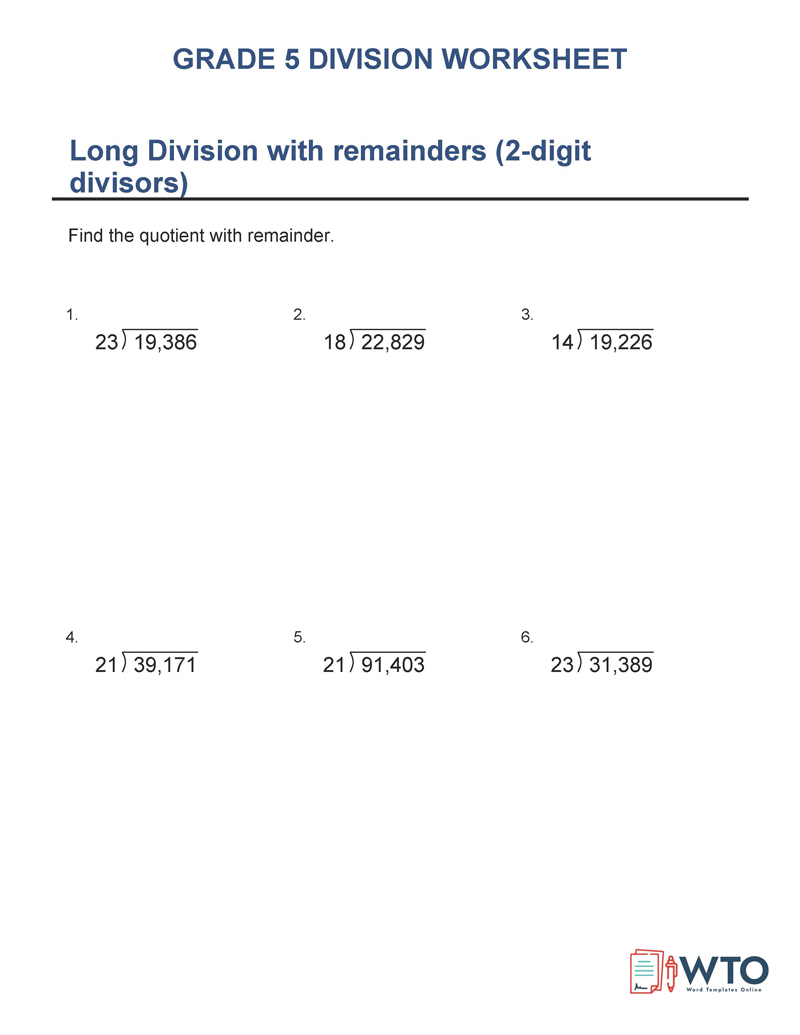
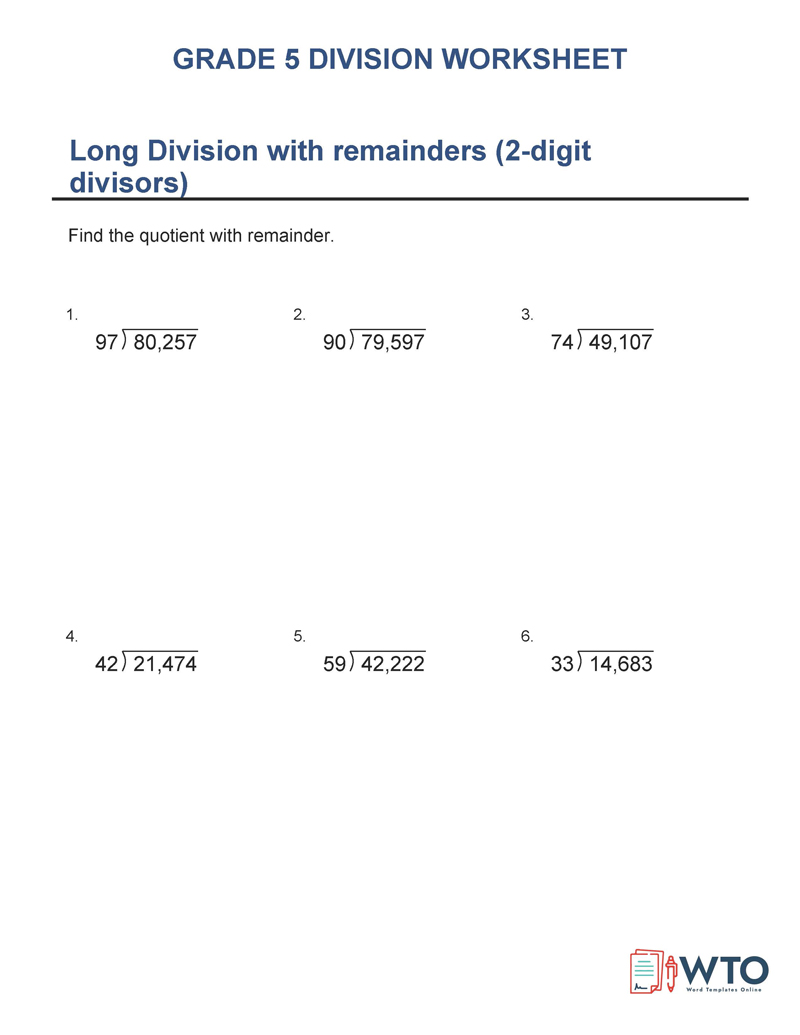
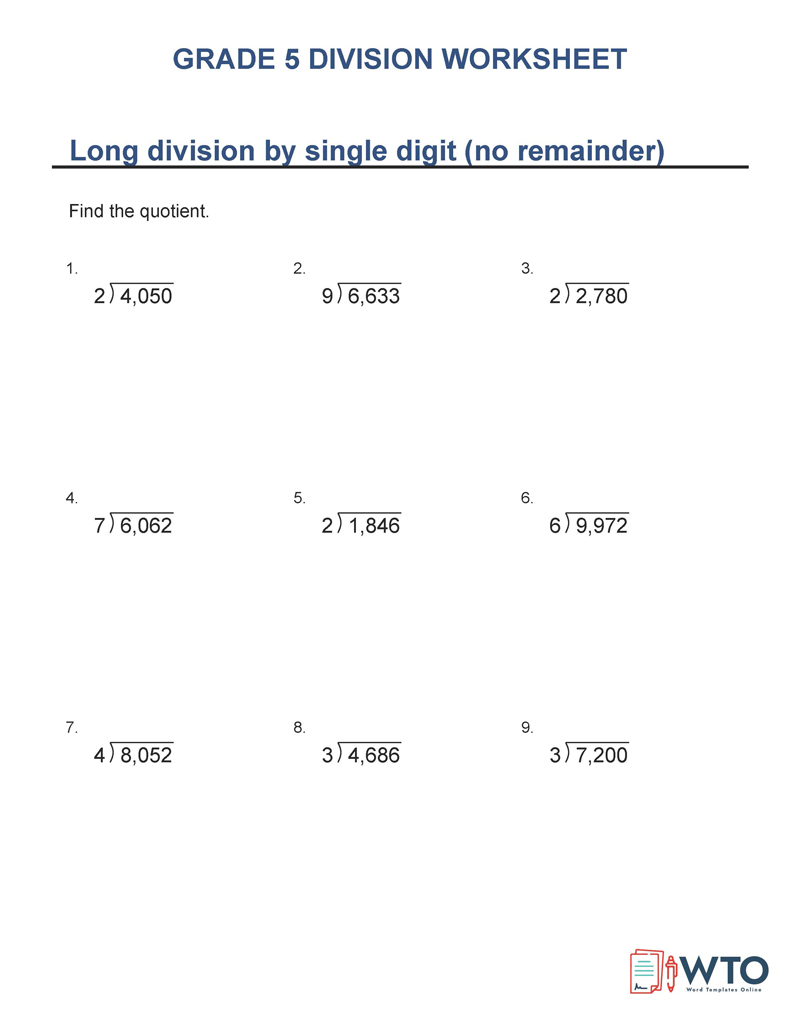
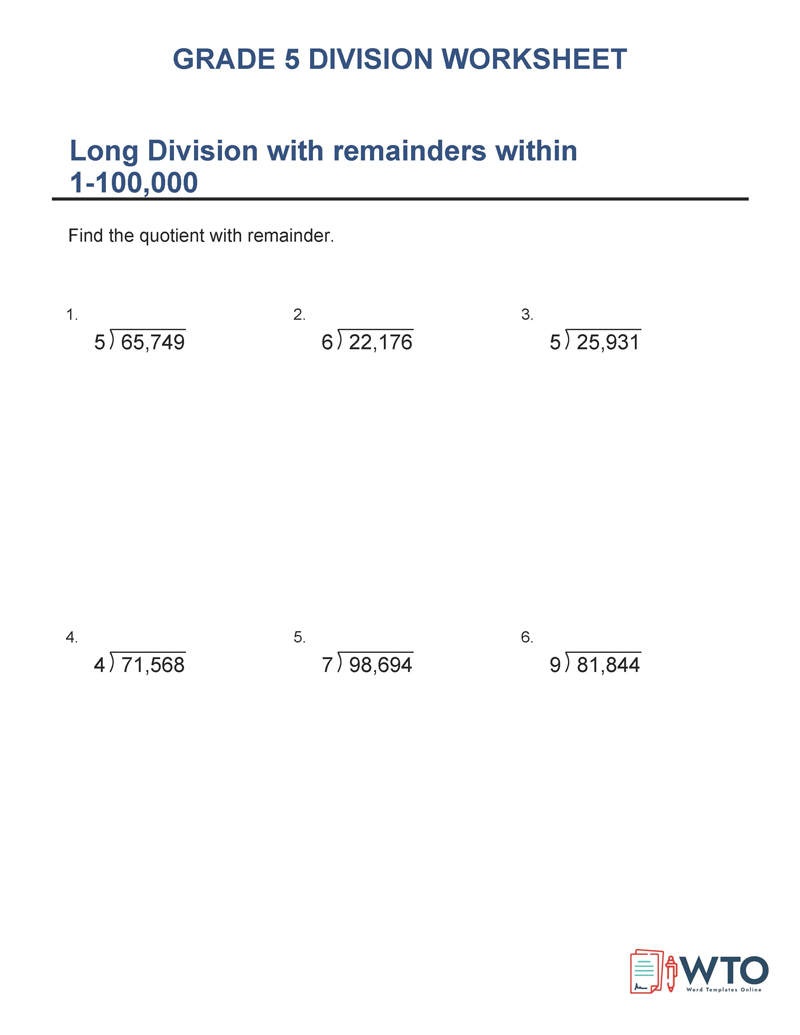
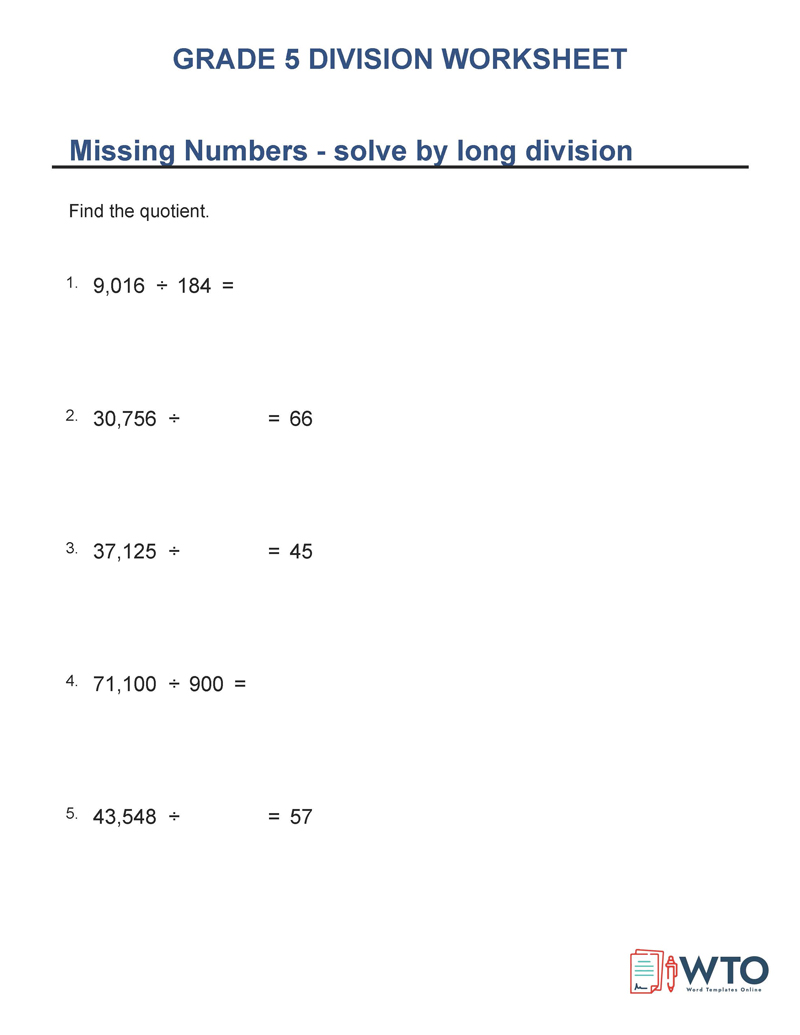
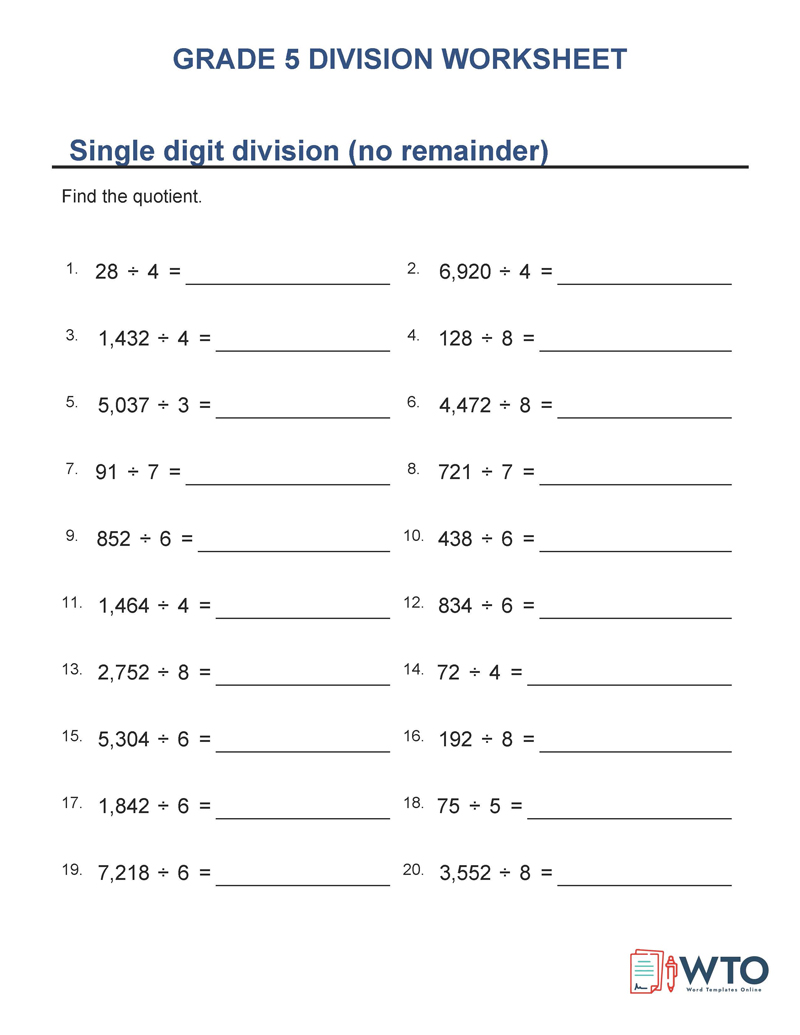
Grade 6 practice worksheet
The worksheet comprises three sections. The first section has single-digit divisors only. The other has questions that require two-digit divisors, and there is also a section that contains divisions that need three-digit divisors. The teachers also have sums with a remainder in this category, but on different pages. The teachers can print the PDF formats of the long division worksheets and give them to their students for practice.
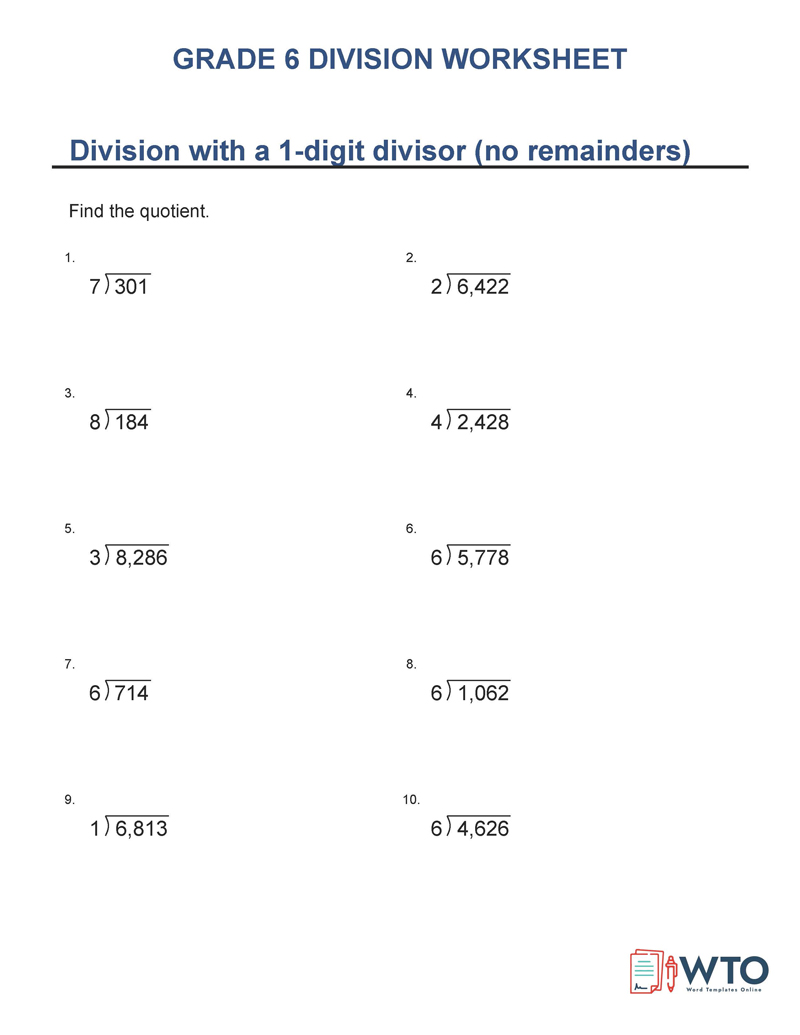
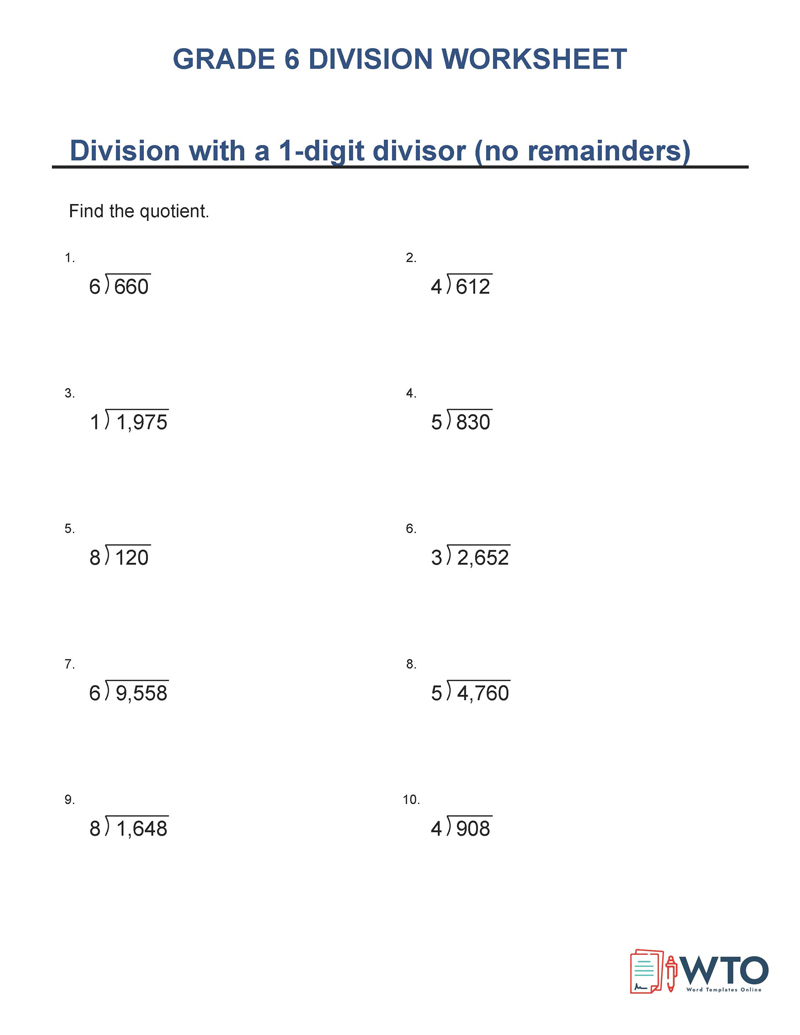
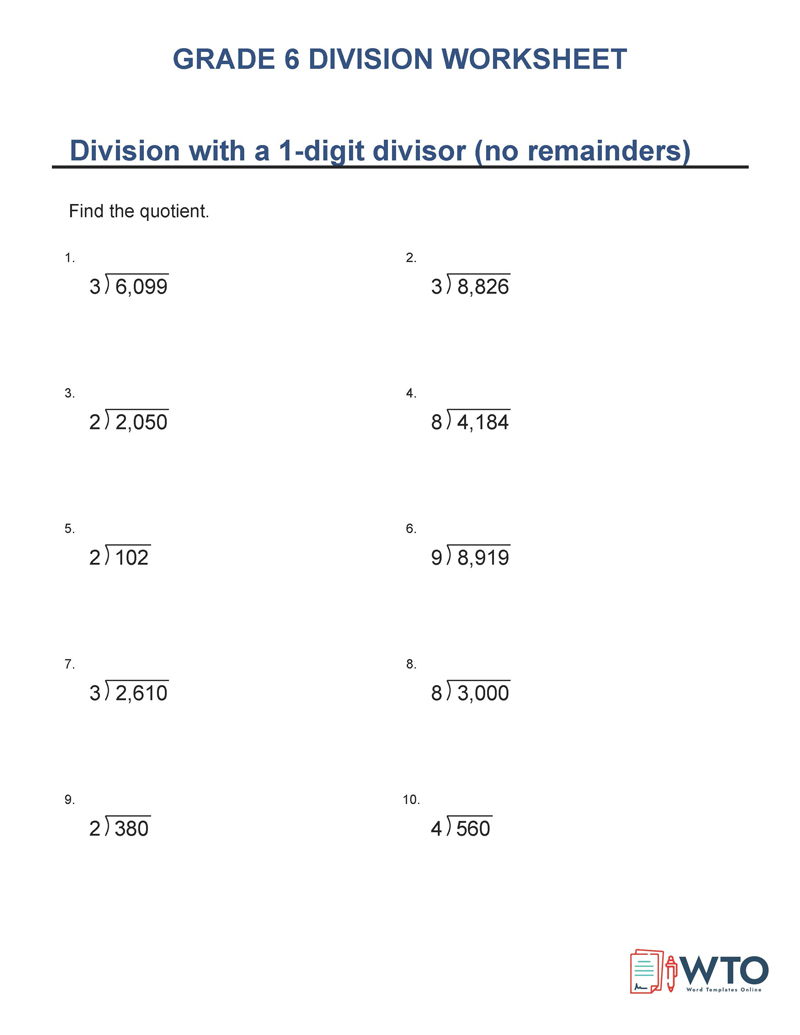
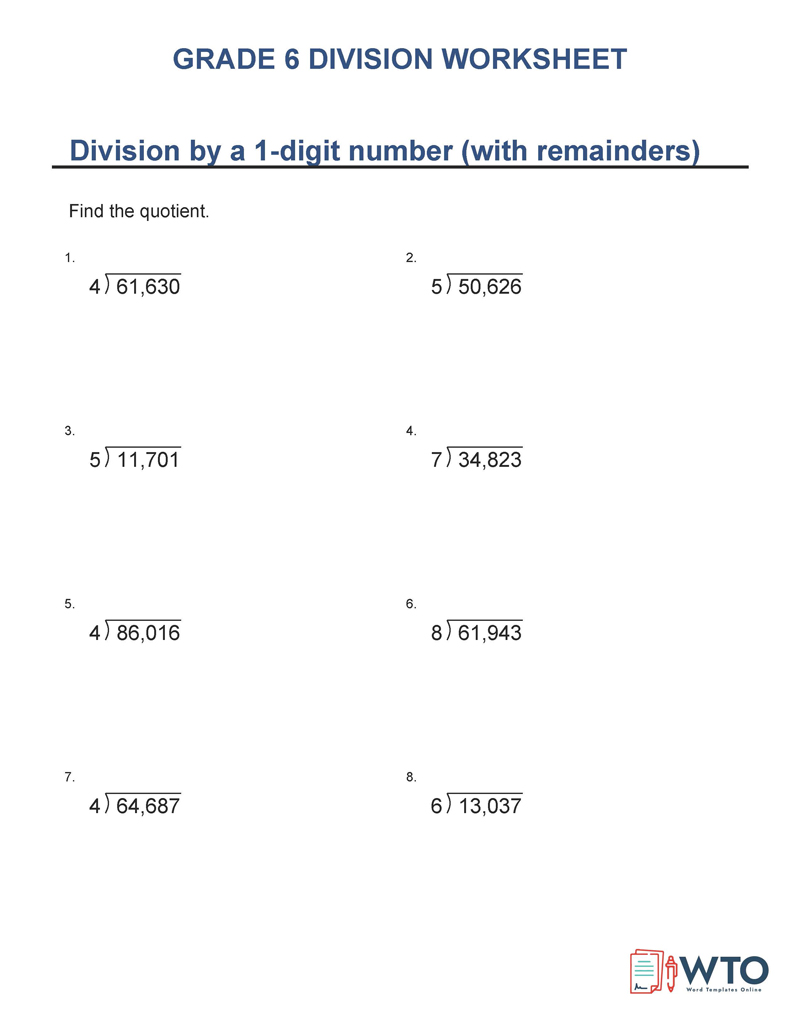
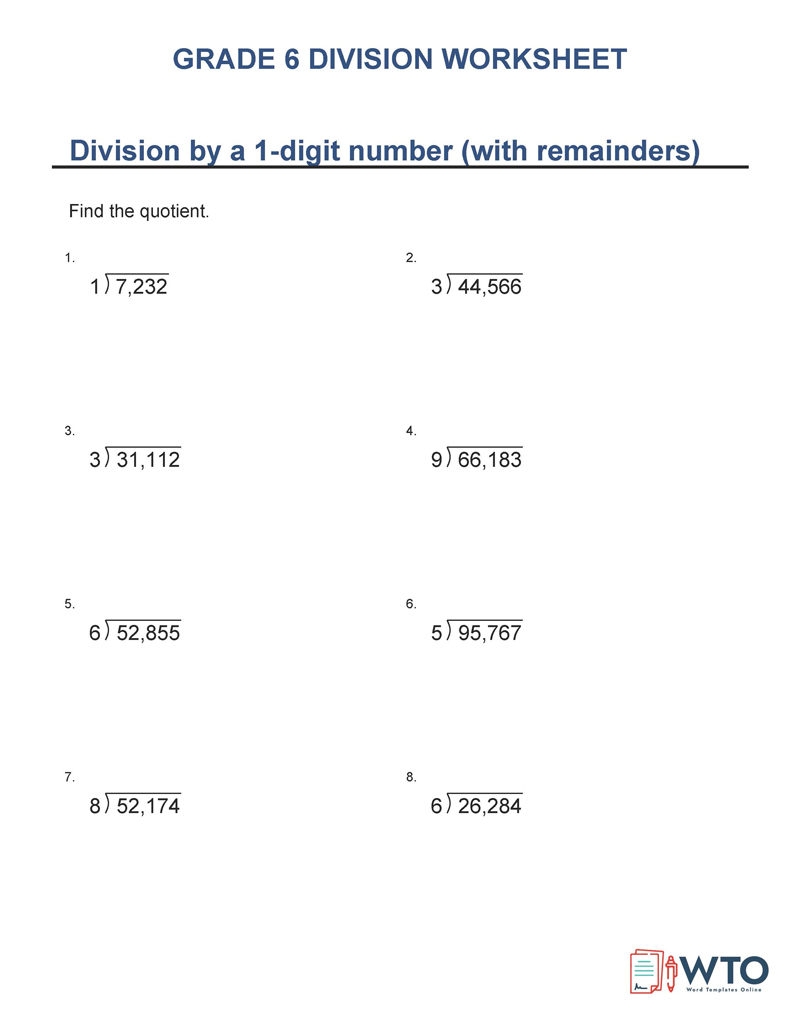
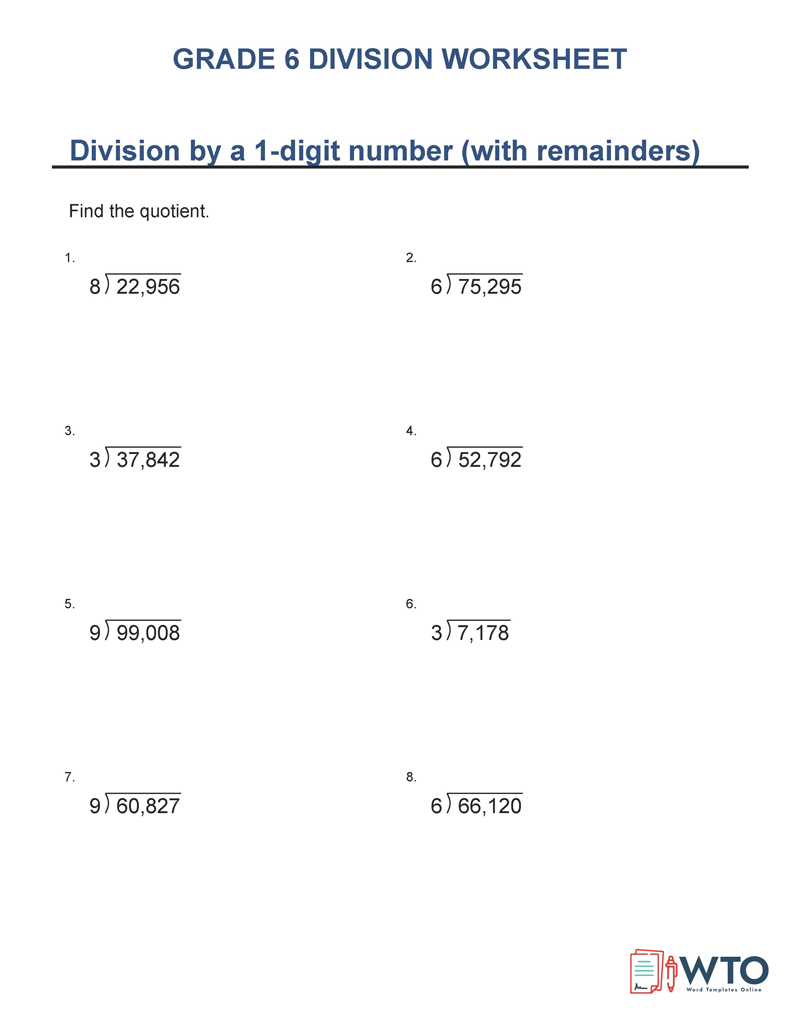
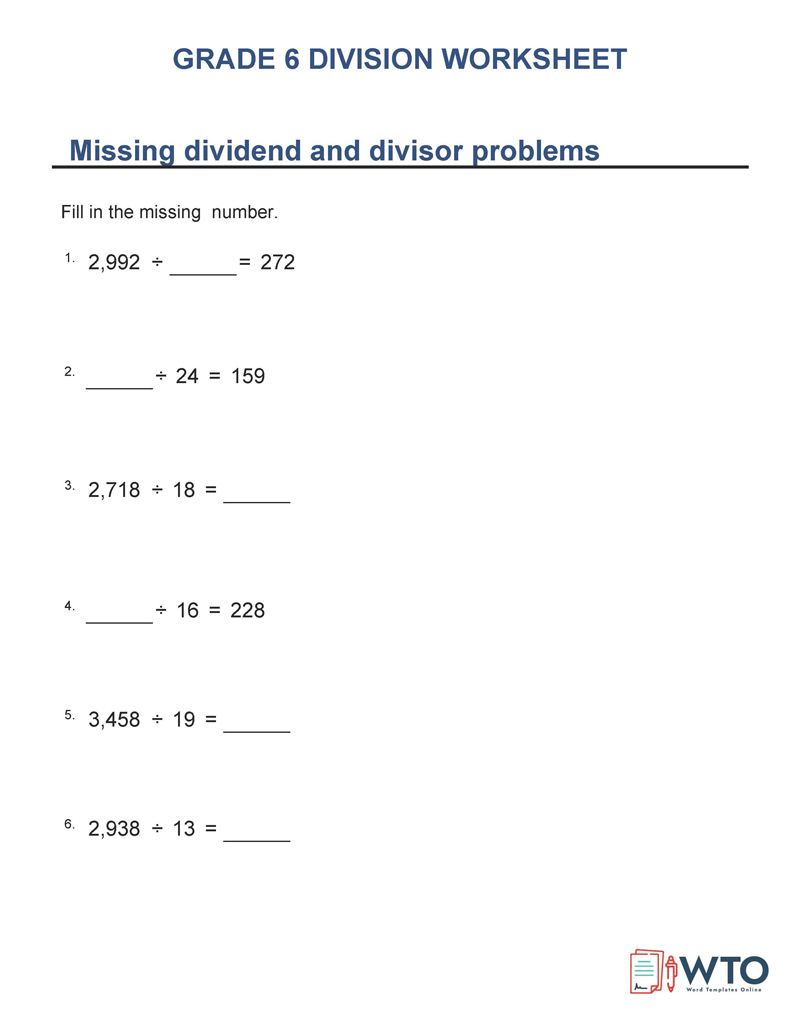
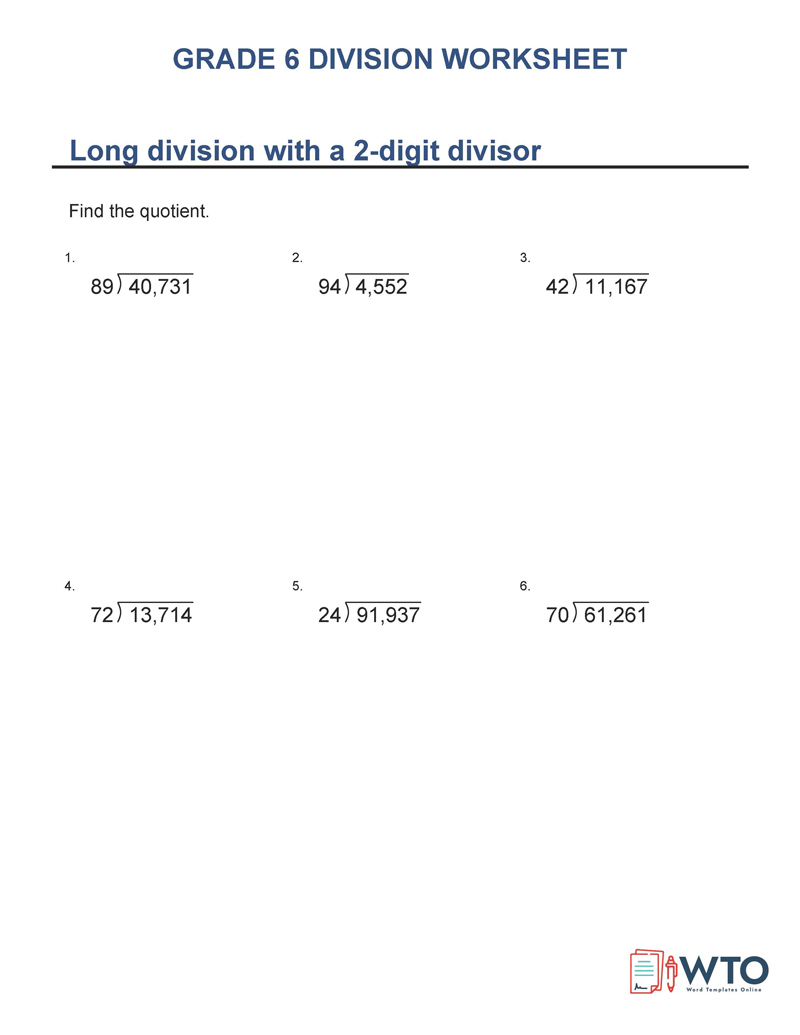
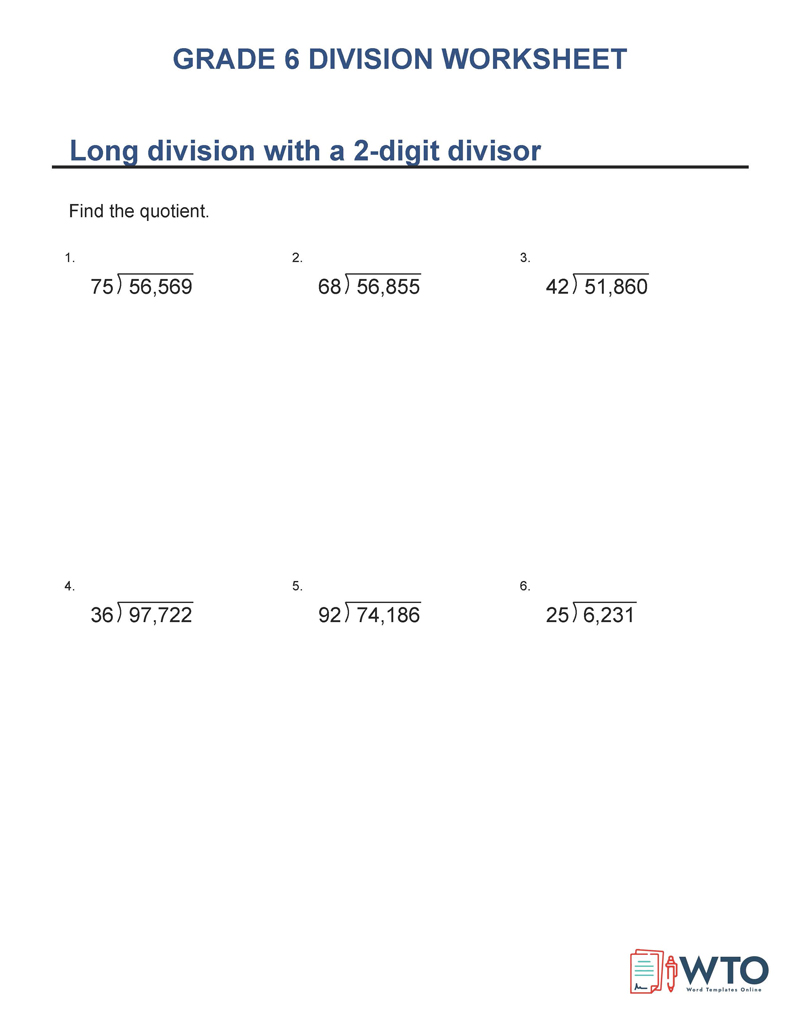
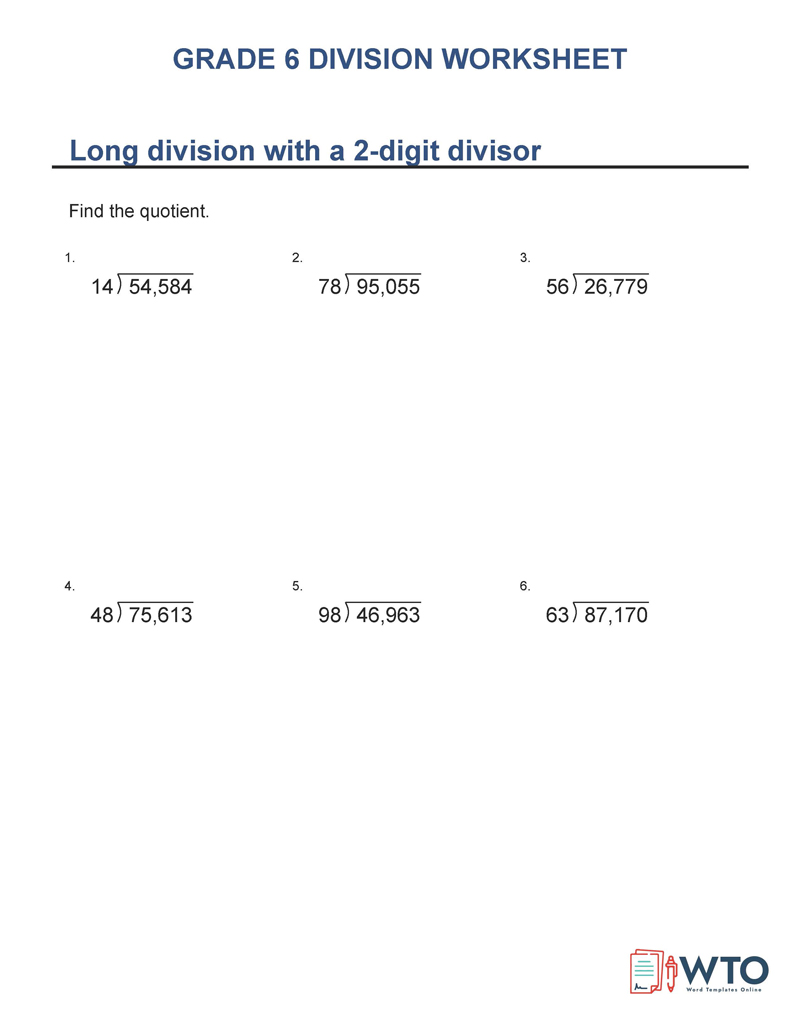
Parts of Division Formula
For your students to understand how to do long division, they must identify the different parts of the formula. Looking at a simple division formula, we can easily describe each of the parts.
These parts are listed below:
12 ÷ 4 = 3, remainder 0
- In the example above, 12 is known as the dividend. It is the original whole number (the group) that will be distributed.
- The divisor tells you how to distribute the dividend. So here, 4 is the divisor because 12 will be split into four equal parts.
- The result you get is the quotient, 3. So if you take the dividend, 12, and split it according to the divisor, 4, you will get four groups of 3 (the quotient).
In cases where a number cannot be split evenly, you would get a remainder. In this case, there is no remainder because it is divided equally. However, in the case of:
8 ÷ 3 = 2
- There is a remainder, 2, as the dividend could not be distributed equally by the divisor, and there are two parts of the dividend left over.
As division is the opposite of multiplication, verifying this and making sure that the answer is correct is possible. In the first example, it is possible to transform it into a multiplication problem to double-check. 12 = 4×3 + 0. By multiplying the divisor and the quotient, then adding the remainder, you should get the dividend.
Using the verification formula Dividend = (Divisor x Quotient) + Remainder, the second example can be proved as well. 8 = (3 x 2) + 2.
Types of Division
Now that your students understand what division is, it is important to explain different types of division. This is a crucial step during instruction because it will help your students have a firm grasp of the concept, ultimately leading them to do better in math. As your students will learn about division very early on, they must continue to learn about different types of division to help them understand the concept thoroughly.
This way, they will start with small numbers and eventually be able to work with larger numbers as well. Additionally, your students should be able to do these calculations as word problems. Not only does this test their understanding of the concept, but it will also improve their abilities to use it in real-life situations.
The following are the types of division:
Quotative division
This type of division is also known as “rate division” because you divide a quantity by a rate. Thinking about our previous example of 12 ÷ 4 = 3, quotative division would be dividing a number (12) into groups of a specific quantity (4), then you get the number of groups (3).
EXAMPLE
If you have 20 students in your class. You can ask them to stand up and get into groups of 5. This would be quotative division because you tell the dividend (20) to be split into groups of a specific quantity (5), with the result of the formula being the number of groups formed (4).
In other words, quotative division is X divided into groups of Y.
Partitive division
This type of division is also known as rate quotient division because the resulting number is the rate. We use this type of division when splitting a large group (the dividend) into a specific number of groups to find out how much is in each group.
EXAMPLE
You could tell the students (20) to stand up and get into two groups. Then, you count how many groups there are (10).
Therefore, a partitive division is dividing X into Y groups.
Long Division
Long division is an extension of the type mentioned earlier. However, instead of using a dividend of 2 digits and a divisor of 1 digit, typically the dividend is 3 or more digits and the divisor is at least 2 digits long.
In long division, a large number is going to be divided by another large number. Although the formula is similar, it has some more steps.
EXAMPLE
In the equation 210 ÷ 14, the dividend (210) would be written on the right, with the divisor on the left. A vertical bar separates the two numbers, with a horizontal bar going over the dividend. Writing them out correctly would be the first step.
It should look like this:
EXAMPLE 1
In step two, you would divide 14 by the first digit of the dividend. Since 14 is bigger than 2, we instead divide 4 into the first two digits (21). As 14 can go into 21 at one time, you would write 1 over 2 in the horizontal bar, like this:
EXAMPLE 2
Then, you would multiply the divisor by the number found (1). As 14 x 1 = 14, you would write 14 underneath the first two digits of the dividend. Finally, you would subtract the two numbers (21 – 14), then write the answer (7) below, as shown here
EXAMPLE 3
In step three, you must bring down the next digit from the dividend. The last digit in the dividend was 0. Therefore, you bring it down with the answer from the subtraction, 7, to create the number 70.
EXAMPLE 4
Now, you divide the divisor into 70, resulting in an equal number of 5. Write 5 on top of the digit 0 in the dividend. Repeat the multiplication procedure from step two, with 14 x 5, then subtract the result from the original number
Here is a visual of this process:
Now you can see that 210 ÷ 14 = 15, with a remainder of 2. This is the process for a number that divides evenly into the dividend. However, you should also teach your students what to do if the number does not divide evenly.
EXAMPLE
In problem 186 ÷ 12, we will need to continue into another step.
If we complete the same procedures as in the previous example, then we are left with a remainder of 6 on the last step.
Although this will be sufficient for some of your math classes, it will not always be the case. You should explain to your students that you can go one step further to find the exact number by dividing it into decimal places.
Explain to them that 186 is the same as 186.0, and so, by using the decimal place, they can bring a 0 down from the remaining 6 to produce 60 instead of only 6.
Then, you can continue the steps as previously described, adding more zeros to the right as necessary. Remember to also add a decimal point to correspond with the dividend.
After that, all the steps are the same. Your end result should be 186 ÷ 12 = 15.5.
Explain to your students that they can continue this process indefinitely for some numbers. The further you go with the calculations, the more accurate the number is.
However, it is not always necessary to have complete calculations for very large digits.For instance, Some divisions could go on infinitely, so usually, the 2nd or 3rd decimal point is sufficient.
Long Division Math Activities
Worksheets are pages that contain exercises that let your students practice several different long-division problems. The most common type contains 15–20 problems and has space to do the calculations. They are of different difficulty levels, with some of them being simple and others being more complicated. These will help students improve their skills through practice.
Of course, long worksheets of divisions are not the only way you can teach your students this concept. There are plenty of fun games you can play in your classroom to keep things exciting and engaging with your students. This will also help them see that math can be used for real life problem solving as well, which is an idea many students struggle with.
Two such activities are explained below:
Spin the spinner in the long division game
This game is quite simple. First, students can create a simple spinner board using two pieces of paper, a pencil, and a paper clip. Then, on each piece of paper, create a circle with 8 equal parts, like a pizza.
For the first paper, roll two dice to create a two-digit number. Next, roll the die eight times to create eight different numbers that can be placed on the page. These will be the divisors. If you want your students to only do easier problems, you can have them only roll one die for each section.
On the second sheet, do the same, but roll two times for each section to produce four-digit numbers. These numbers will be the dividends. Now, place a paper clip in the center of each paper and use a pencil to hold it in place. Your students can flick the paper clip to make a DIY spinner board. They would spin twice to get the divisor and the dividend, then solve for the quotient.
You can make the game more fun by giving them timers or rewards for doing it quickly and correctly.
Long division differentiated color by number
This is an easy game for your students. You can find coloring sheets online for free. Each section of the sheet has a long division problem. The quotient corresponds to a specific color. So, for your students to complete the page and know what colors to use, they must solve all the long division problems. This is an excellent activity for a day when you would like the class to be a bit more relaxed.
Final Thoughts
Math is one of the most challenging subjects to teach, especially since many students find it frustrating and demotivating. That is why you, as a teacher, should find ways to make it as easy as possible.Division is one of the basic principles that your students need to learn. Therefore, the best plan is to explain it gradually. Start with easy topics and slowly introduce more challenging problems. This way, your students will not become overwhelmed, and you can identify where the student lacks comprehension immediately.Feel free to use this guide to explain the concept of division to your students and include some of the games and worksheets in your class.








